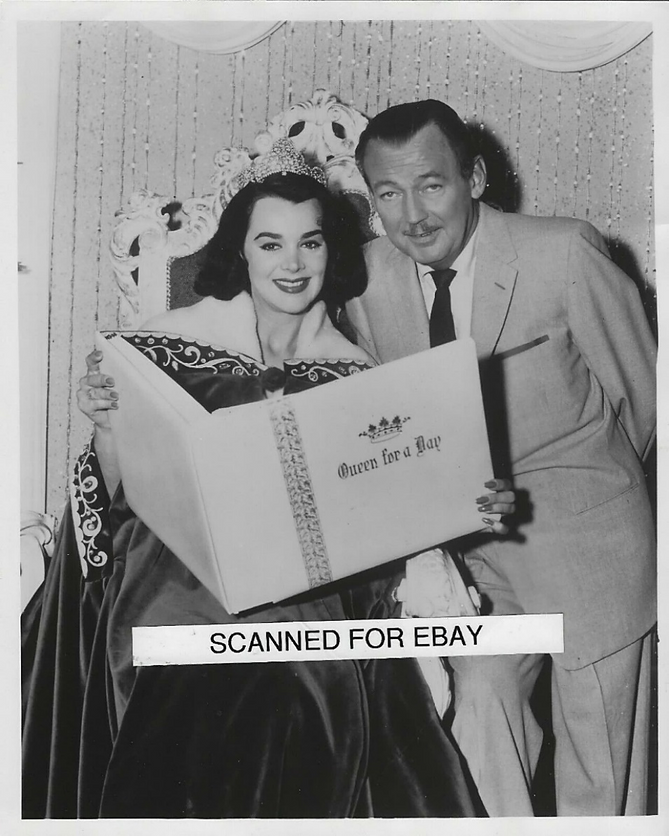Introduction 8
Early Years 12
Hollywood 24
Primetime 32
Decline 50
Later Years 59
Afterword 70
Filmography 74
Television 75
Pageants 78
References 79
Index 92
Author 100
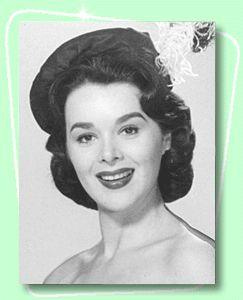
Introduction
Suzanne Alexander was one of the most talented, gorgeous, and likeable women in Hollywood. She was also one of the most underrated. Her dark hair, distinct voice, and flawless complexion was popular with audiences on television, as she was seen daily on Queen for a Day and weekly on Juke Box Jury. She was one of the go-to models for agencies who needed an attractive, yet classy woman to showcase everything including fashion, swimwear, appliances, and cosmetics. Her impressive measurements of 36-23-35 at 5ft 6in and 118lbs fit the requirements of Hollywood’s unbelievable high standards of beauty.
She was phenomenally talented; in fact, she was more talented than audiences realized. She was a fine actress who had immense range. She could portray anyone in any genre.
She was a great dramatic actress who a gift of comedy, which was rare for actresses of that era. This was expected considering that she studied acting alongside stars like Grace Kelly.
Anyone who was close to Suzanne remembers her as being a kind person. Hollywood is bombarded with people who are pretentious, assuming, and disrespectful. This never applied to Suzanne. Even as her career progressed, she maintained humility. As her career declined, she stayed positive. She had class that was unmatched by anyone in Hollywood.
I decided to write about Suzanne Alexander because I was impressed by her talent and charm, but saddened by her death. I found it ashame that Hollywood didn’t see Suzanne as a star the way that I saw her after seeing her in Cat-Women of the Moon (1953). I saw that she starred alongside Fred Astaire, Joan Collins, Rita Moreno, Jane Russell, and Debbie Reynolds, but was confused as to why she didn’t achieve the same success that they did. Suzanne Alexander was an icon of glamour in the 1950s, and I am honored to tell her story.
Early Years
Gwendolynne “Suzanne” Alice Ann White was born on September 8, 1931 in Toronto, Canada to William White and Gwendolyn Haynes. Her father was a renowned concert entertainer, while her mother was -an unofficial- Miss Canada of 1918. Unfortunately, her mother didn’t achieve the success that she yearned for, so she tried to achieve it through her daughter Suzanne. A controlling and authoritative mother would create enormous difficulties for Suzanne throughout her childhood.
Suzanne began performing as a teenager when her mother enrolled her and her brother Will J. White in figure skating.
Although they weren’t among the best athletes, they were recognized for their abilities to perform in the presence of an audience. Seeing their potential, their instructor recommended that they study acting. They were gifted, particularly Suzanne with her glamourous image and natural abilities to portray in-depth characters. Their family moved to Pennsylvania and later New York after Will was accepted to the renowned American Academy of Dramatic Arts. Suzanne
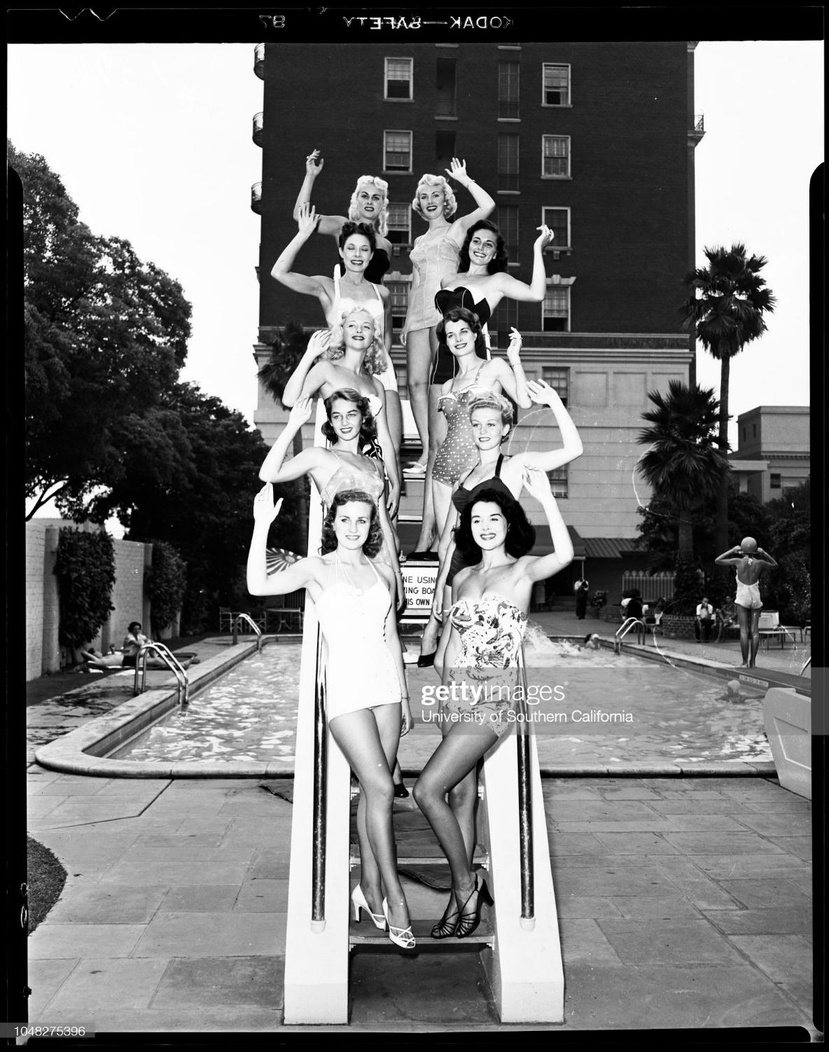
lived with her aunt until she got
accepted into the institution.
Suzanne had ambitions to be a
dramatic actress and vocalist,
while Will focused on being a
“character” actor. She officially
immigrated to the United States of
America on March 25, 1947.
Suzanne graduated from the
American Academy of Dramatic
Arts in 1948 -with actress Grace
Kelly- where her brother had
graduated from years prior. She
moved with her family to Los
Angeles, California to pursue a
career in Hollywood, where she
The Finalists in Queen of the Home
was fortunate enough to be hired
Show - July 29, 1952
as Dinah Shore’s secretary; it was
a position that she held for three
years, and it gave her the
opportunity to rub shoulders with
actors, producers, and directors.
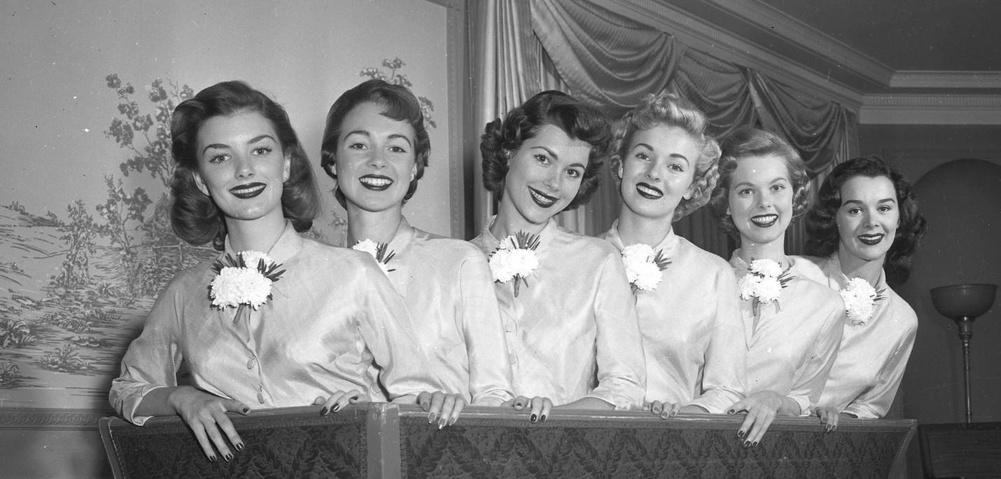
She began building her resume by competing in pageants, in which she was successful. She was crowned Miss Studio City of 1949, Miss San Fernando Valley of 1949, Queen of the Fiesta of 1950, Miss Vegetable Plate of 1953, and was a finalist in Queen of the Home Show in 1952. She received the “key to the city” by Studio City’s Chamber of Commerce after being crowned Miss San Fernando Valley. The last surviving contestant of that pageant, Teri Reid (her stage name), described Suzanne as being unusually withdrawn, shy, and reserved. Although that seemed unusual for an aspiring actress, Marilyn Monroe had exhibited those qualities too.
Suzanne Alexander with Stephanie Griffin, Grace Brown, Barbara Wilson, Jean Moorhead, and Nancy Woodruff in Miss Rheingold – September 1954
After being crowned Miss San Fernando Valley on May 7, 1949 by Frank Galpin, she competed for the title of Miss California in Santa Cruz, California. The competition began on June 9th and concluded on June 12th with 21 contestants.
This all-expenses-paid trip was one of the most memorable parts of her career. She stayed at the Rio Del Mar Hotel and dined at the Cocanut Grove. She was truly given the 5-star treatment.
The festivities were hosted by Bill Baldwin with music provided by the Santa Cruz Beach Symphonic Band. She placed an impressive fourth after performing a monologue that was telecasted on KPIX, which critics described as breathtaking. She accepted honors onstage -bestowed by Lieutenant Governor Goodwin Knight- in a white swimsuit in front of roughly 25,000 spectators. Her prizes included a radio and a handbag. Joan Pederson of Santa Rosa, California would be crowned Miss California of that year, and would compete for the title of Miss America shortly thereafter.
A lot of publicity followed, with producers and agencies expressing interest in casting her. She was considered for stage productions like Aunt Sarah and Detective Story while appearing at venues like the Studio City Community Fair and the grand opening of Glendale Federal Savings.
On April 28, 1950, Suzanne finally got her first televised role on the series Club Time opposite Bob McLaughlin where she portrayed a secretary. She retired from contests afterwards and focused on her career as an actress, while continuing to live with her recently-divorced mother on Moorpark Street in Studio City, California. A brief engagement to music mogul Jerry Lester followed, but ended partly because of Suzanne’s fear of leaving her mother.
Her relationship with her mother was unusual and co-dependent. Even after reaching adulthood, Suzanne and her mother had an evening ritual where they would soak their hair in water for several minutes, drink a glass of red wine, and hold hands as they fell asleep in separate beds that were perpendicular with each other. Although Suzanne discussed this ritual with friends as though it was normal, it could’ve been a reason for her fear of marriage as she would have to leave her mother.
Gwendolyn Anne Haynes
Suzanne’s mother, Gwendolyn, one raised by John J. Haynes Sr. and Alice Maud Mottram who immigrated to Canada from England. Her mother was -ironically of course- an actress and part-time stenographer who achieved modest success by starring in a stage production of Daddy Long Legs. She was the oldest of several daughters, thus constantly competed for
attention. This translated into her desiring fame. She married Will J. White Sr. on December 31, 1923 in Detroit Michigan, shorlty after her divorce from Arthur B. Bowes. Gwendolyn had a brief year of stardom in Canada. She starred in Victory’s Call to Canada (1917) opposite Thomas White where she played “Miss Canada”, which was contrary to her stories that she was actually Miss Canada.
Although the movie was well-received, an acting career never materialized for Gwendolyn as she was not a trained actress.
Since then, she had hoped that Suzanne could achieve what she hadn’t. They were both beautiful and shared a lot of similar features, such as their cheekbones. Suzanne had something that her mother didn’t have though, which was talent.
Will J. White Sr.
Suzanne’s father, William James White Sr, was a multitalented entertainer who did acting, music, and comedy. He performed throughout Canada at venues like the Princess, the Cobalt Opera House, the Rebekah Concert, Town Hall, Victoria Hall, the A.O.U.W, and the Independent Order of Foresters. They were usually specials or revues. North Bay Nugget hailed him as “Canada’s favorite comedian” while The Times called him
“Canada’s leading humorist.” His career stalled after his father
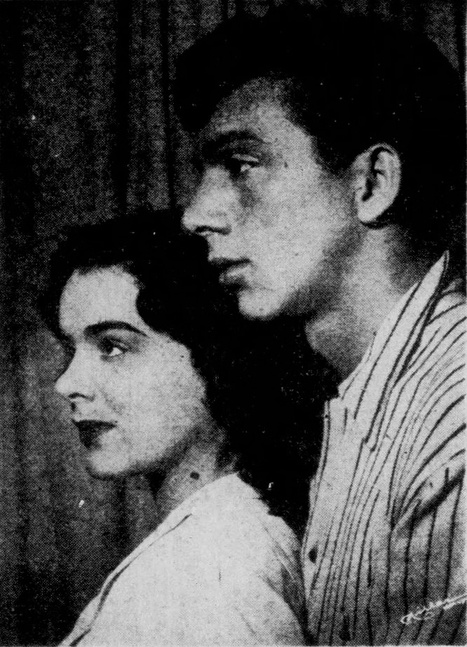
James passed away, as he spent years caring for his grieving mother Arine “Annie” Sagroff.
Similar to his wife, Will wanted his children to achieve the fame that he wanted but didn’t get. Needless to say, expectations were that Suzanne -and her brother- would excel as entertainers considering who her parents were in Canada. They would discover that fame in America could prove more troublesome.
Suzanne Alexander and Frank Fiumara
in Detective Story - July 1951
Theater
After intense training, she joined the Gateway Stock Company. She began acting onstage in the production of Time and the Conways June 28, 1948 in Morristown, Tennessee. It was afterwards that she got her first reviews, and they were outstanding. The New York Critics’ Circle labeled her as "one of the most outstanding young actresses in America" while Malcolm Millerof of The Knoxville Journal said "Gwendolynne White was well cast for the role of psychic Kay Conway. She presented a beautiful picture as she sat by the window in the moonlight, trying to fathom the future of the confused Conways."
Dear Ruth was her next onstage success. She played the title character alongside Thomas Legate. The Morristown Gazette Mail called her "extremely talented and beautiful". She left the company to star in the off-Broadway production of The Enchanted Cottage at the John Drew Theater alongside Susan Peters, but it was cancelled soon afterwards.
Her most prolific onstage role was in Detective Story at the Ivar Theater on June 4, 1951 -starring Allen Jenkins- while appearing on television in series like Schlitz Playhouse and China Smith, the latter of which she portrayed a Latina helping detectives locate stolen drugs. The reviews of the production were positive, with columnist Mozelle Dinehart
saying that “Her [Suzanne’s] career is zooming.” A romance ensued between her and the production’s star, Frank Emanuel Fiumara. Her parents were not fond of her dating an Italian, so she often met with him in secret. Although they were together for years, they never married as Suzanne promised her father on his deathbed that she wouldn’t marry him.
Unfortunately, Detective Story concluded that year. Suzanne kept herself occupied though, as she was modeling for Thrifty’s Drug Stores and the American Association of Advertising Agencies. Her acting career progressed with roles on Ladies Matinee with Jack Rourke and Photography is Fun in a risqué segment titled “How to Pose Nude.” Unfortunately, these were forgettable roles where she portrayed models. She was hoping for the opportunity to leave modeling and become a serious actress; quoting every model ever,
“Modeling is the most boring job in the world.” Suzanne’s hopes would soon come to fruition.
Hollywood
Suzanne’s first notable role on television was on the series Racket Squad, appearing in two back-to-back episodes as Lillian Lester. The story consisted of a widower who must support herself while raising her daughter, then losing custody of her daughter for false allegations of neglect. Mimi Gibson, who played her daughter, remembers Suzanne as being sweet and uncorrupted by Hollywood. They took a lot of photographs together, which Mimi has among her possessions. It was that year that she used the name “Suzanne Alexander” rather than her actual name “Gwen”. It was an idea of her mother’s that was meant to copy one of the characters, the aspiring performer Susan Alexander, in Citizen Kane (1941).
Raiders of the Seven Seas (1953) was Suzanne’s first appearance in a movie, and it would be one of several colorful
“Arabian night” themed movies that she would appear in.
Although it was an uncredited role as a handmaiden, she was honored to perform alongside Donna Reed in a pivotal scene where she alerts the guards that Barbarossa entered the
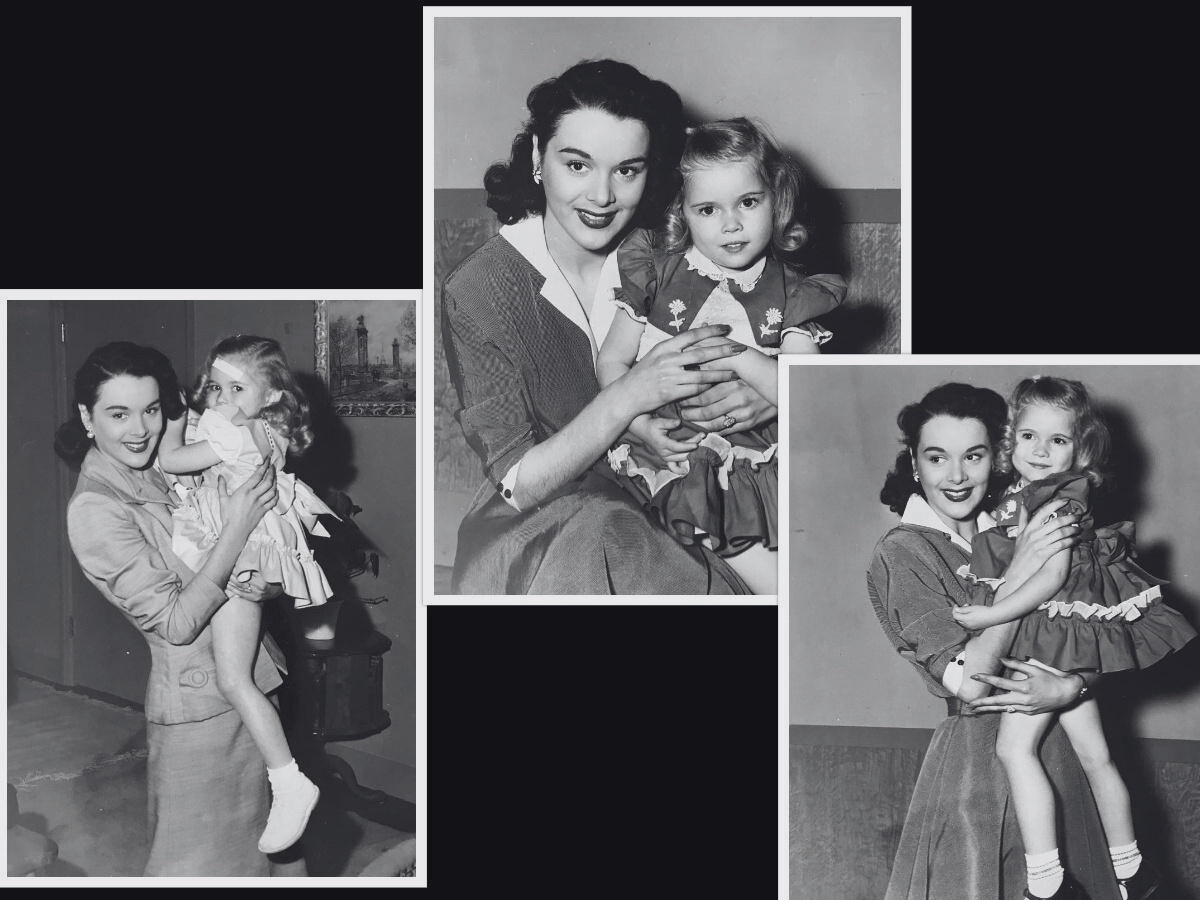
palace. Latin Lovers (1953)
was her second role in a
movie, and it would be one
of several in which she
would portray ethnic
characters that were
contributed to her dark hair
and flawless complexion. It
was another uncredited role
where she played an
unnamed Brazilian, but she
shared the screen with star
Lana Turner; it was another
fond experience in her life,
but a realization that blondes
were more desirable
onscreen than brunettes.
Suzanne Alexander and Mimi Gibson
Blondes got starring roles
on Racket Squad - 1952
while brunettes played
supporting or ethnic
characters.
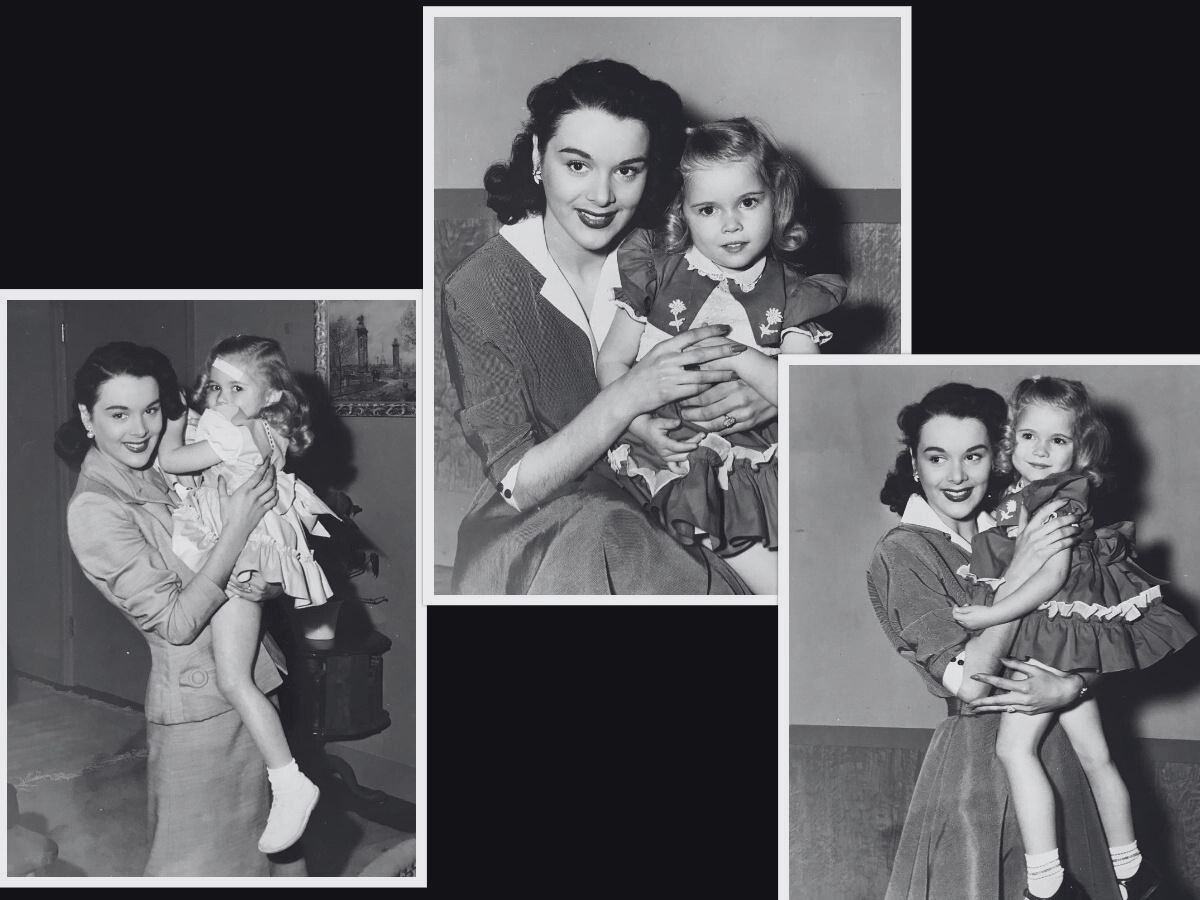
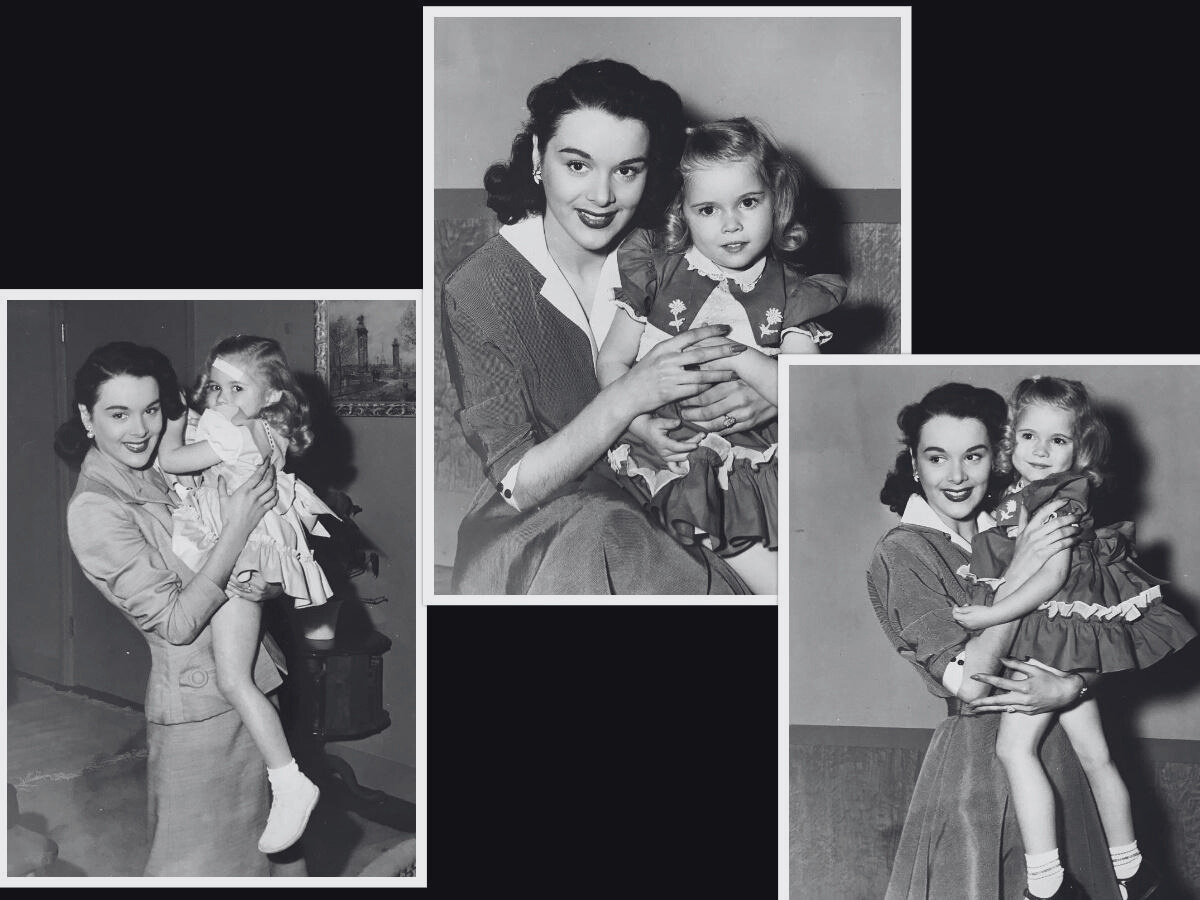
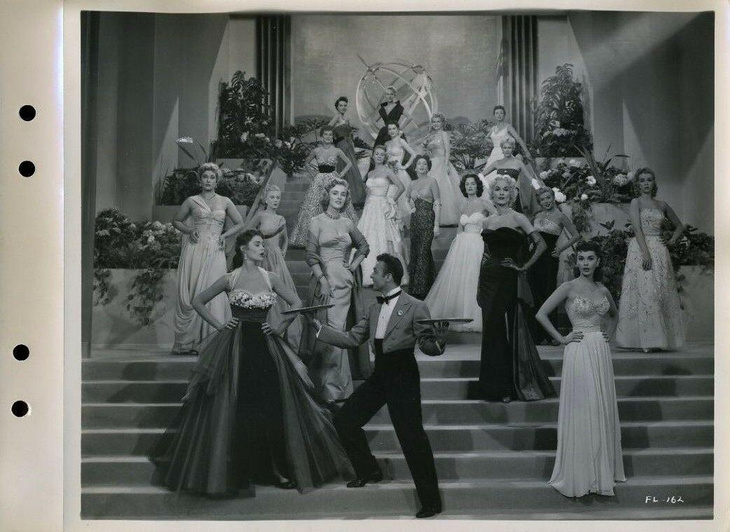
Her third movie was The Affairs of Dobie Gillis (1953) starring Debbie Reynolds, where she was one of five unnamed co-eds at the fictional Grainbelt University. Her fourth movie was Flight Nurse (1953) where she played Madonna, a former girlfriend of one of the wounded soldiers who appears -with no dialogue- during a drug-induced hallucination. Although it was a slower-than-expected progression to stardom, she was thankful to have four big-budget movies and several television series on her resume.
Suzanne Alexander in The French Line (1954)
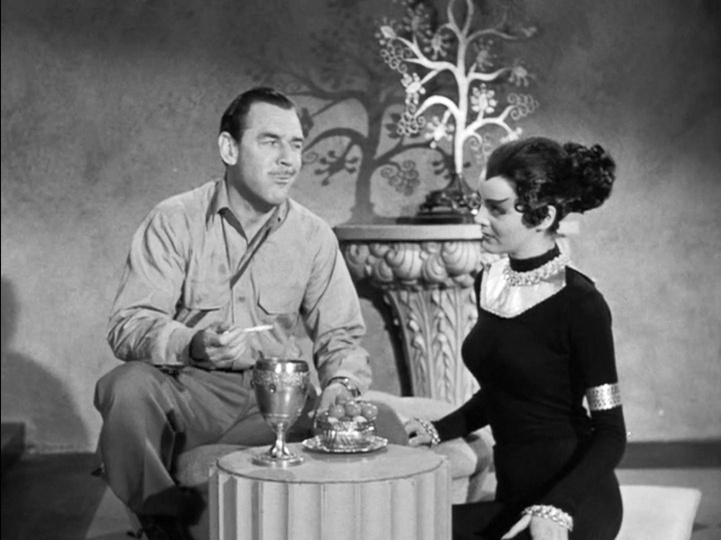
Suzanne Alexander in Cat-Women of the Moon (1953) In 1953, Suzanne was discovered by Howard Hughes on a beach in Santa Monica, California. Howard had managed RKO Pictures for years, and he had developed a hobby of signing unknown -but beautiful nonetheless- models with the hopes of transforming them into stars. Although a romance never happened, he admired her beauty, class, and respectability. He signed her to a contract with RKO Pictures, which followed with a role in The French Line (1954) where she is seen descending the stairs in the “Any Gal From Texas”
scene with actresses Kim Novak and Pat Sheehan. A role in Son of Sinbad (1955) followed, which was iconic for its cast that included 106 actresses. Both of these movies were filmed in 3-D.
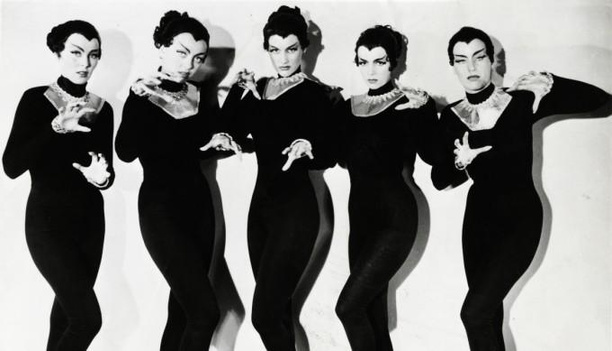
Her role in the Son of Sinbad (1955) -as a Harem Girl- was more substantial, as she is seen winking at Sinbad (portrayed by Dale Robertson) as he is awaiting sentencing.
Unfortunately, Suzanne was among hundreds of actresses whom Howard Hughes had signed for RKO Pictures. There was a lot of competition, and roles were scarce. Suzanne’s mother was annoyed that her daughter wasn’t getting enough attention, and she asked Howard Hughes to release her from her contract.
Suzanne was now free to audition for larger roles. Cat-Women of the Moon (1953). It was her first major role onscreen; she portrayed Beta, a villainous alien –alongside the villain Alpha portrayed by Carol Brewster- who murders two of the story’s heroes (one with a knife after luring him to a cave of gold, and the other with a rock to thwart her escape) before being killed herself. It was her first and only role as an antagonist, but she
did fantastically well in that role while proving that she had more range as an actress than she had been given credit for.
She gave perhaps the most infamous and important line of the movie, “We have no use for men”, which helped foreshadow the following events in the storyline. Although it was a low-budget sci-fi movie, it is credited by historians as having paved the way for the sci-fi genre. It would continue to see success in double-features at drive-in theaters, often being paired with movies directed by Roger Corman. It was also praised for its soundtrack, which was composed by Elmer Bernstein.

Suzanne’s outstanding performance caught the attention of Louis Shurr, who was one of Hollywood’s most successful agents having represented stars like Bob Hope, Ginger Rogers, and Dolores Gray. Louis’ methods as an agent included transforming starlets into stars by rejecting low-budget movies. He agreed to represent Suzanne on the condition that she not do another low-budget movie, nor that she do another unsympathetic role.
His fear was that she would be typecast -a fate that actresses June Kenney and Yvonne Lime suffered- and that it could limit her career. He also persuaded her to use the name
“Suzann Alexander” rather than “Suzanne Alexander in the credits of Cat Women of the Moon and reject any publicity (interviews, pictorials, etc) associated the production.
Although Suzanne could’ve had a great career in that genre, she, Louis, and -of course- her mother saw Suzanne as being destined for greater things.
Suzanne Alexander in Princess of the Nile (1954) ->
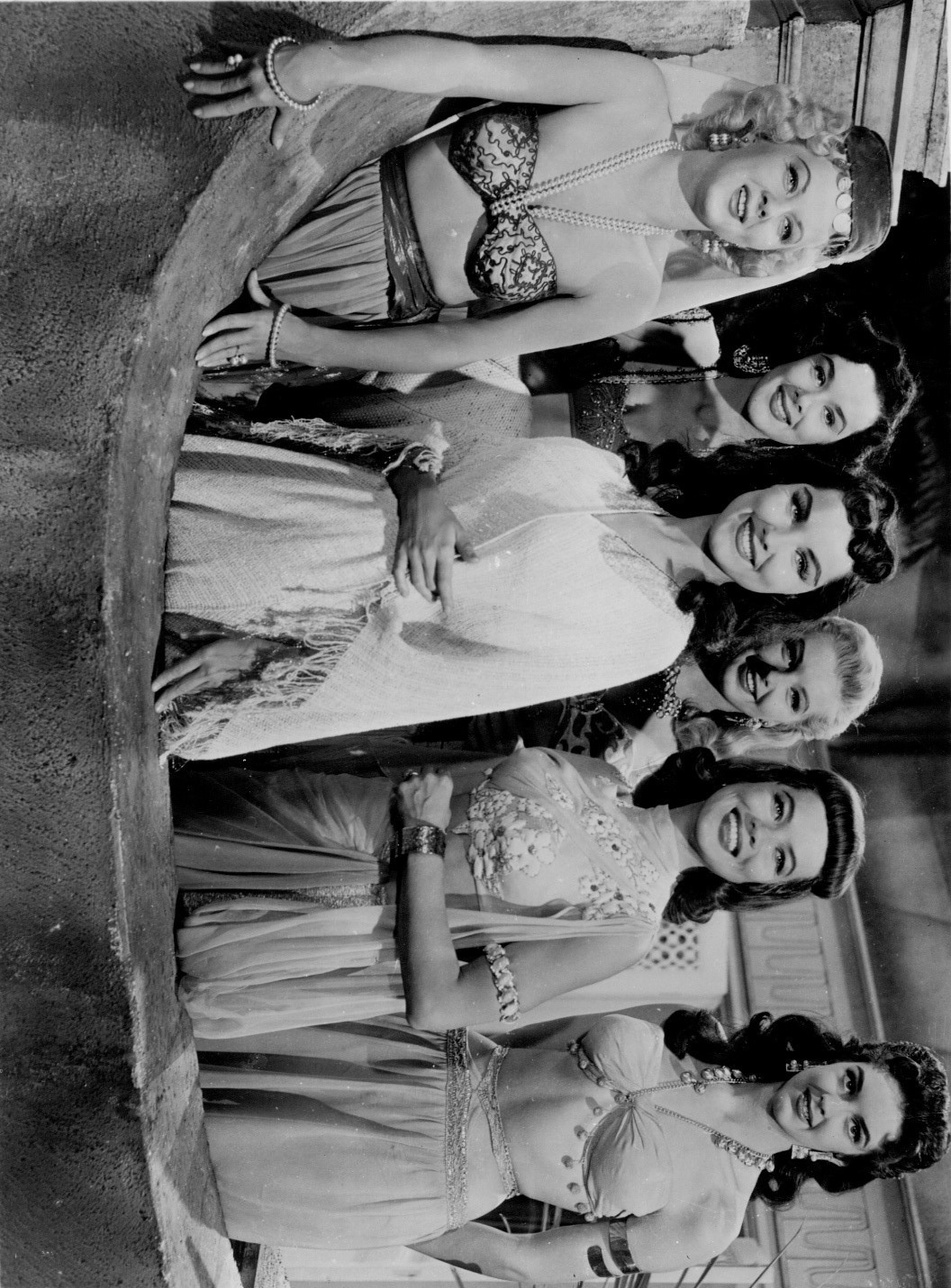
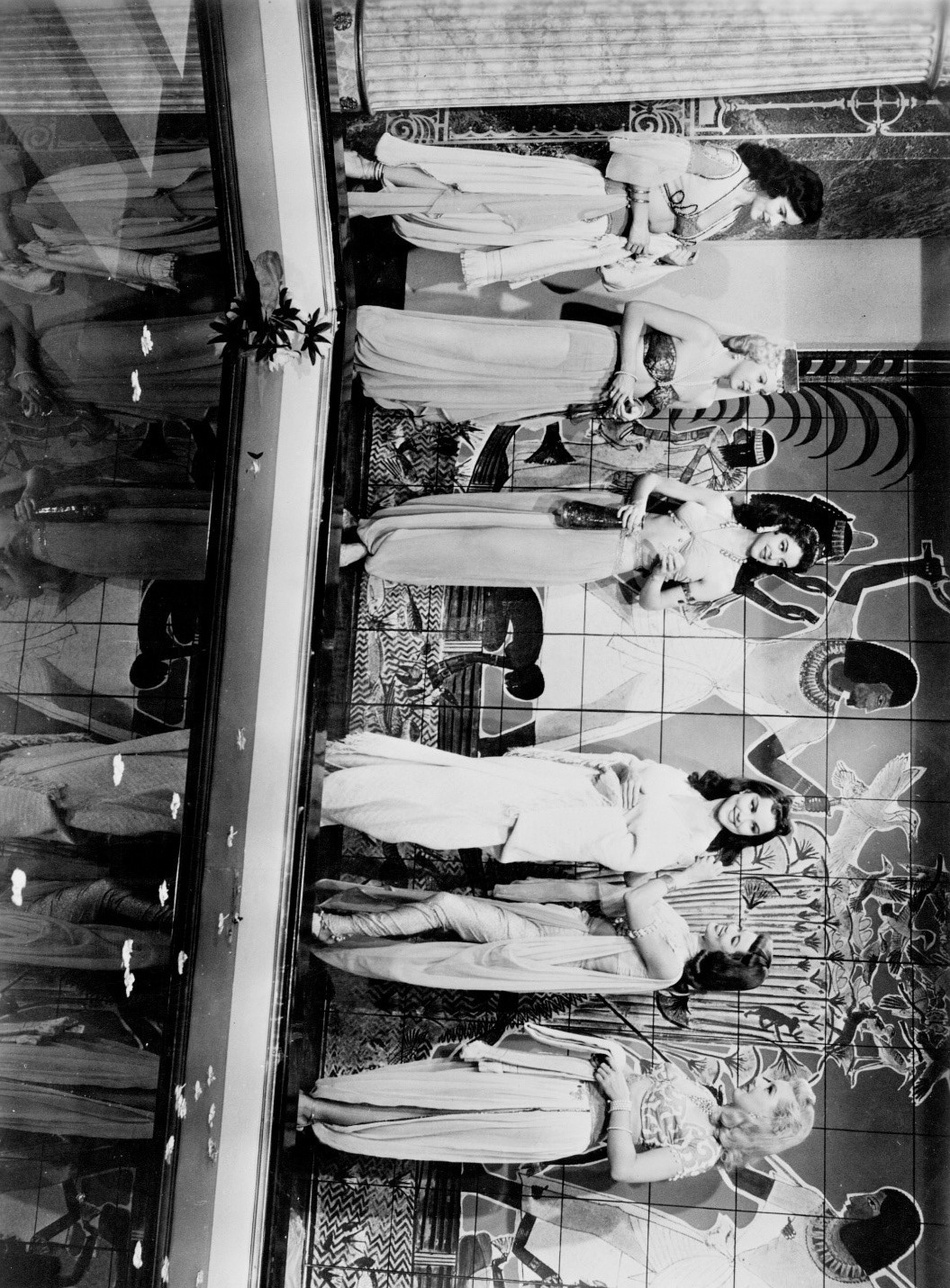
Things seemed promising under Louis’ guidance. He got Suzanne her first supporting role onscreen in Down Three Dark Streets (1954), which starred Broderick Crawford and Ruth Roman. In this drama, Suzanne played Brenda Ralles.
She gave another outstanding performance by demonstrating her ability to cry on demand while opting for a shorter hairstyle to fit the script. Her character is murdered and tossed in a dumpster. Although reviews of the movie were lukewarm, it was a defining performance in her career. Critics agreed that Suzanne was underused in the production however, with Glenn Erickson saying “Getting short shrift below the three top-billed actresses is the cute, dark-eyed Suzanne Alexander, who is given only a couple of on-camera moments to shine.”
Hollywood had been good to her until March 1954 when her paycheck was stolen by Robert Bacigalupo, a window washer.
In what was a slow week in the news, Suzanne’s pictorials were splattered in the Daily News and the Los Angeles Times.
Thankfully, police officers arrested the thief a day later and Suzanne’s paycheck was returned to her.
Miss Rheingold
Between appearances onscreen, Suzanne competed for the title of Miss Rheingold in 1954. A popular pageant in the 1950’s that was sponsored by Rheingold Brewery, Suzanne was a finalist who competed alongside Barbara Wilson, Jean Moorhead, Stephanie Griffin, Grace Brown, Nancy Woodruff, Rosemarie Bowe (Robert Stack’s soon-to-be wife), and Suzanne Ames. She also shook hands with baseball player Willie Mays while touring to promote the pageant. They would compete in New York for the crown, but Suzanne ultimately did not win. She would -with finalist Rosemarie Bowe- act as a judge the pageant a year later. She soon began modeling leather jackets at Wilson’s House of Suede.
“I ran into Suzanne at the Farmer’s Market shortly after her father passed away. He made her promise on his deathbed that she wouldn’t marry Frank [Fiumara]. She was devastated, but she loved her father and respected his wishes.” – Barbara Wilson on March 11, 2022
Barbara Wilson was one of the six finalists for Miss Rheingold that year, as well as a credible actress. She recalled that Suzanne’s mother escorted her to the pageants, which supported the belief that she was overbearing. She also remembered that Suzanne was smitten with an Italian man named Frank Fiumara, the aforementioned actor whom her parents strongly opposed. She felt that Suzanne’s eventual suicide was the result of years of grieving that she never married the man she loved.
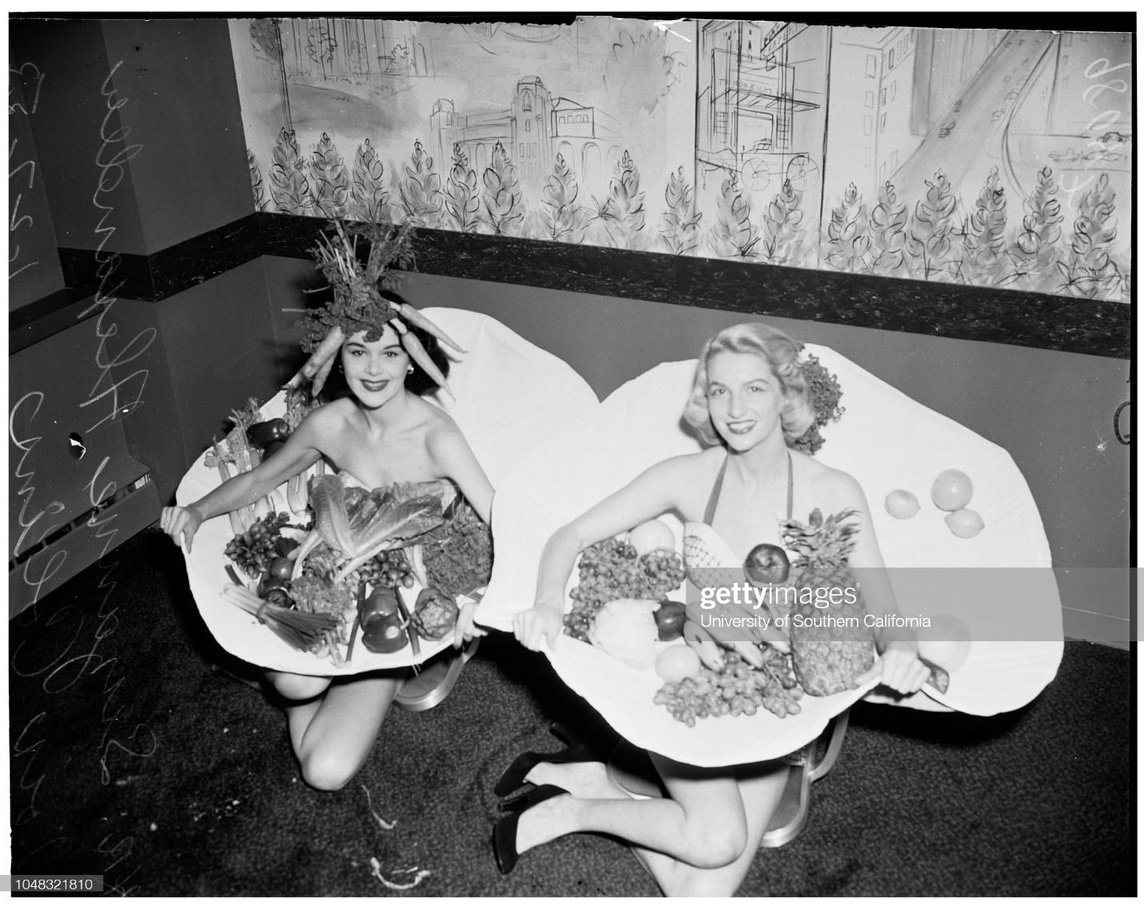
The six finalists of Miss Rheingold were told to summarize themselves and their interest in this competition, which Suzanne did nicely in their brochure:
"Can it happen to me? I asked myself the same question before I got my first part in the movies. Now I'm asking you, “Can I be Miss Rheingold 1955?” What am I like? In one way, serious. I want to be a good dramatic actress. In another way, not so serious. I play the piano to relax, go swimming, riding, and ice skating. Someday, I’d like to make the long trip to Australia. But for now, I’ve got another thing on my mind. I’d like to be your favorite girl, and I know her name is Miss Rheingold 1955.”
Suzanne Alexander as Miss Vegetable Plate of 1953 at the Statler Hotel - January 27, 1953
Primetime
Suzanne began modeling on Jack Bailey’s Queen for a Day in 1953 on a part-time basis while pursuing other opportunities.
Queen for a Day had reached the height of its popularity on daytime television, with notable models like Maxine Reeves, Pat Sheehan, Carol Silversparre (she named her daughter after Suzanne), and Gloria Moore being on staff. Suzanne mainly presented housewares and attire to audiences while occasionally presenting awards to the winner. It was after her first appearance on the series that Suzanne would find fortune.
After her first appearance concluded, Suzanne walked to her car to meet with the other models for coffee at the Hollywood Plaza Hotel when she was seen by Peter Potter. Peter had been a successful disc jockey and host, and he was searching for a co-host for his series Juke Box Jury where celebrities would identify songs for prizes. He approached her and -
captivated by her charm and class- offered her the role. Even though it was another “model” role that required no talent, it was a steady paycheck that merely demanded an hour a day
on her schedule. She also realized that it would give her more exposure on primetime television, hence more opportunities for legitimate acting.
Suzanne was now a regular on two successful series, and became a familiar face on television. She would do rehearsals on Queen for a Day from 11am until 12:15pm, later doing Juke Box Jury in the evening on the same lot. It was the ideal schedule for an actress, as she had enough time to audition for other roles.
She landed walk-on roles in Princess of the Nile (1954) starring Debra Paget and The Girl in the Red-Velvet Swing (1955) -hand-picked by producer Charles Brackett- starring Joan Collins while appearing on three episodes of The Bob Cummings Show. In March of that year, she graced the cover of the magazine Pageant and appearing in the issue’s article
“The Very Model.” She would model for the magazine again in January 1956. She had a role in Daddy Long Legs (1955) weeks later in the “International Playboy” scene where she is seen draped in fur and reaching towards Fred Astaire as he descends the stairs. Joi Lansing and Barrie Chase are in the sequence as well.
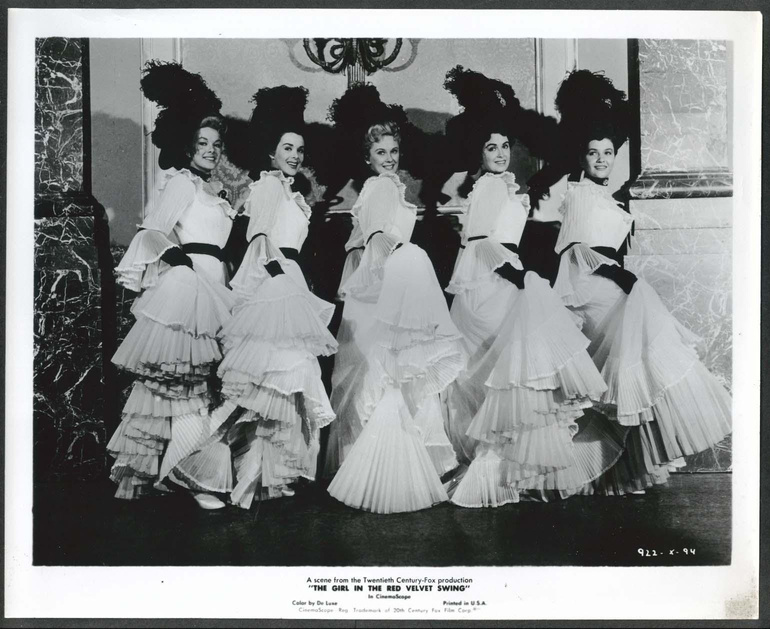
On April 7, 1955, Suzanne starred on an episode of Public Defender titled “The Sapphire Mink” in what was seen as a caricature of her career. The story consisted of a model who moves to Hollywood to pursue a career as an actress only to find herself modeling coats because she is deemed “too classy” to appear onscreen. It was arguably her greatest performance of her career, prompting photographer Elmer Holloway to do a photoshoot with her in the attire that she wore during filming. Her fans were captivated by a scene in which she wore no makeup, which was rare for any starlet of that era.
Suzanne Alexander in The Girl in the Red-Velvet Swing (1955)

“We modeled on Juke Box Jury
together for years. Peter [Potter]
was my brother-in-law, which is
how I got the job. Suzanne was a
very troubled girl. She was quiet, shy, and introverted. I’m not
surprised that she committed
suicide. She was a great model
though. I was particularly
suspicious of her brother. He
looked nothing like her… he was a
fair-skinned blonde while she was
an olive-skinned brunette. One of
them must’ve been adopted or
something.” – Lisa Davis on March
4, 2022
Suzanne Alexander, Suzanne Ames, Jann Darlyn, and Mayor Sidney Lord in
Australia - April 12, 1956
Suzanne Alexander and Peter Potter on
Juke Box Jury ->
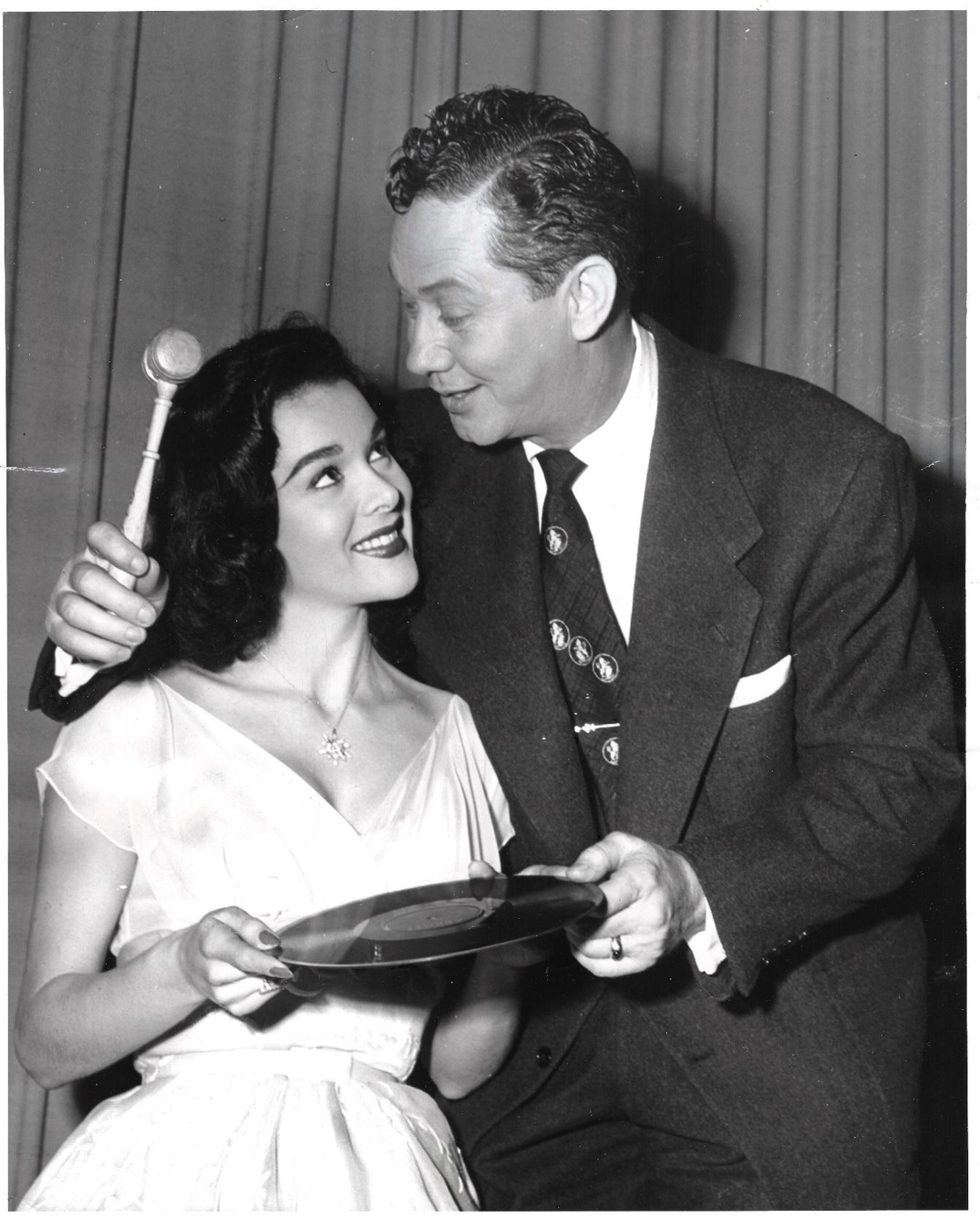
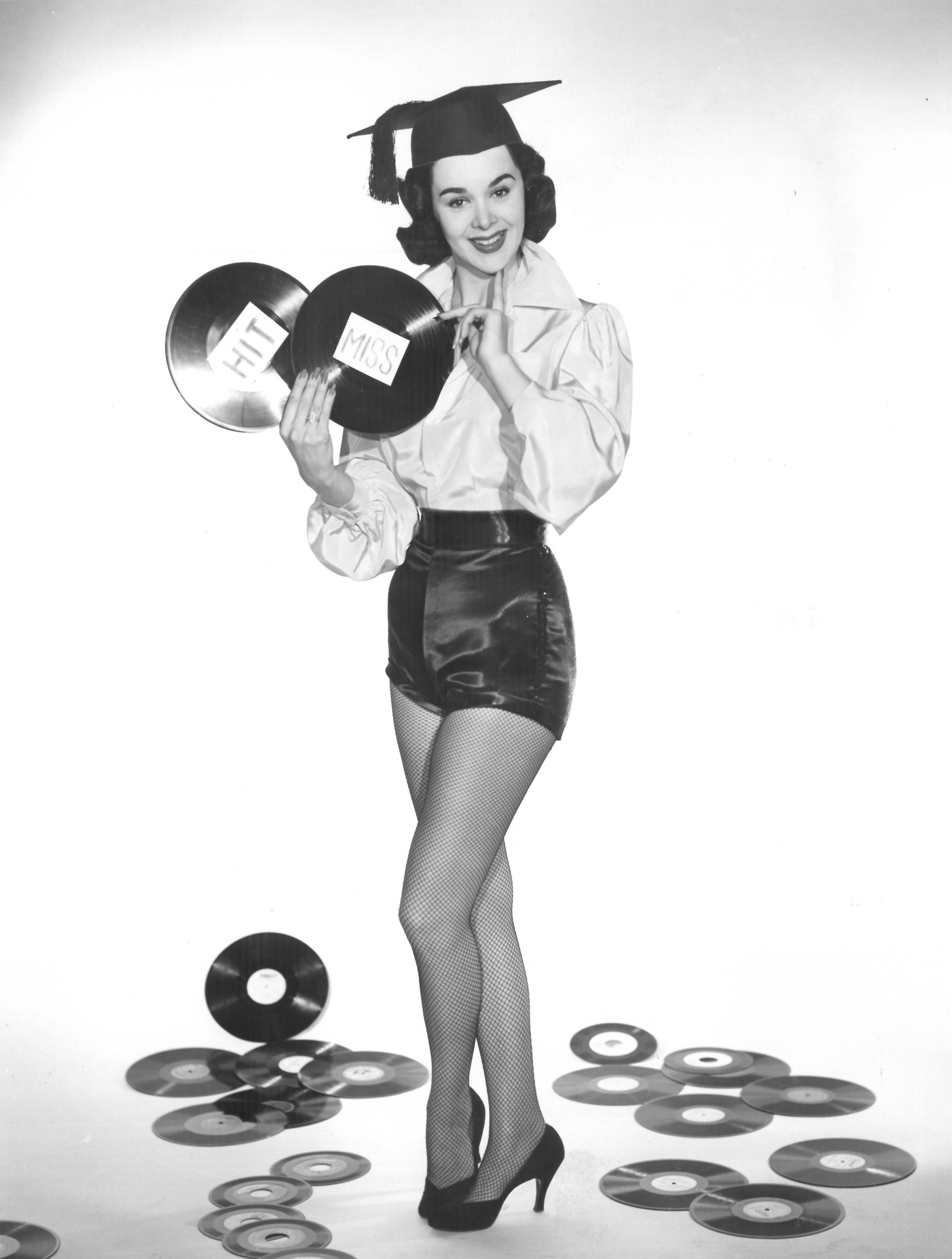
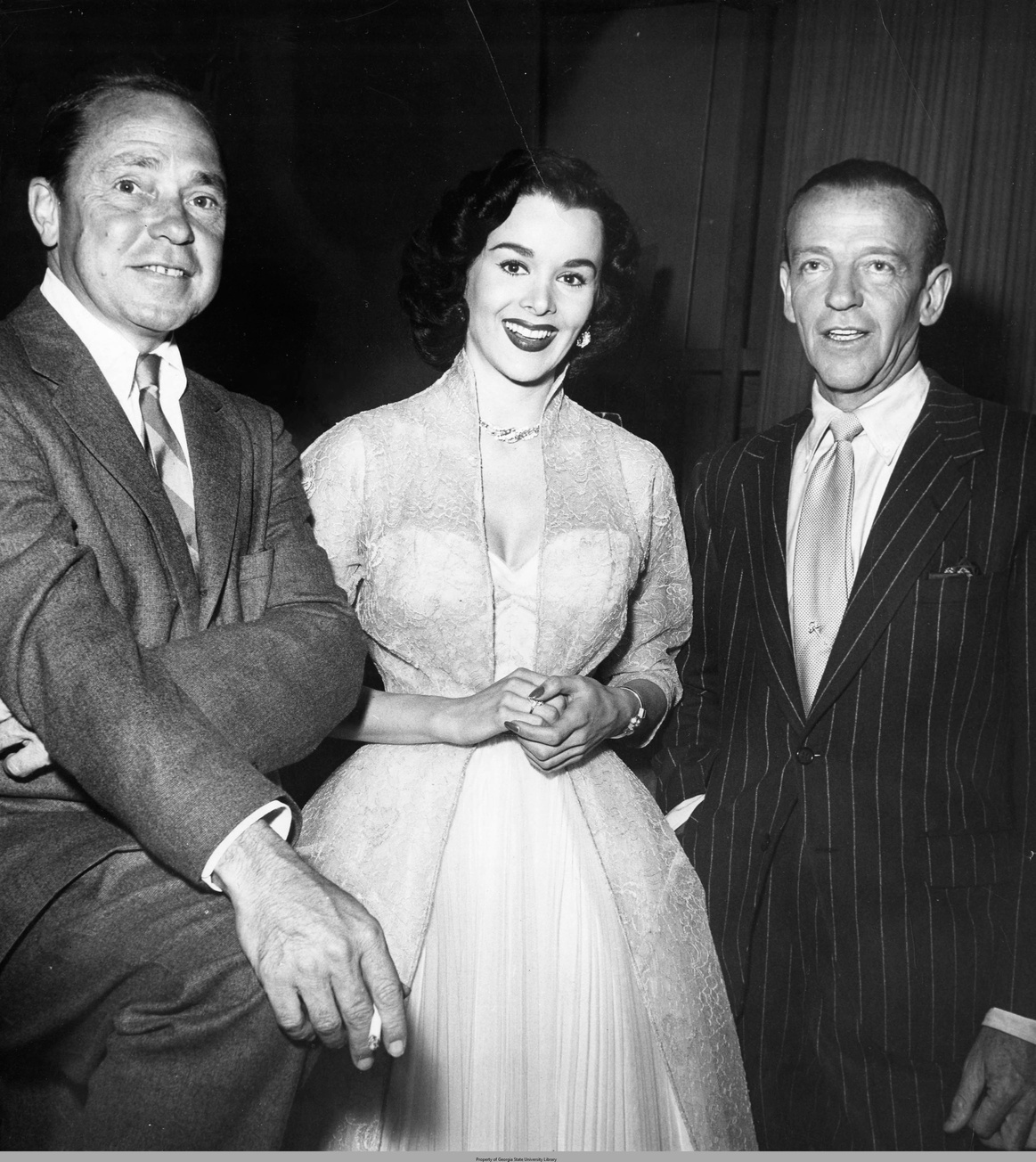
Suzanne Alexander and Jack Bailey on Queen For a Day ->
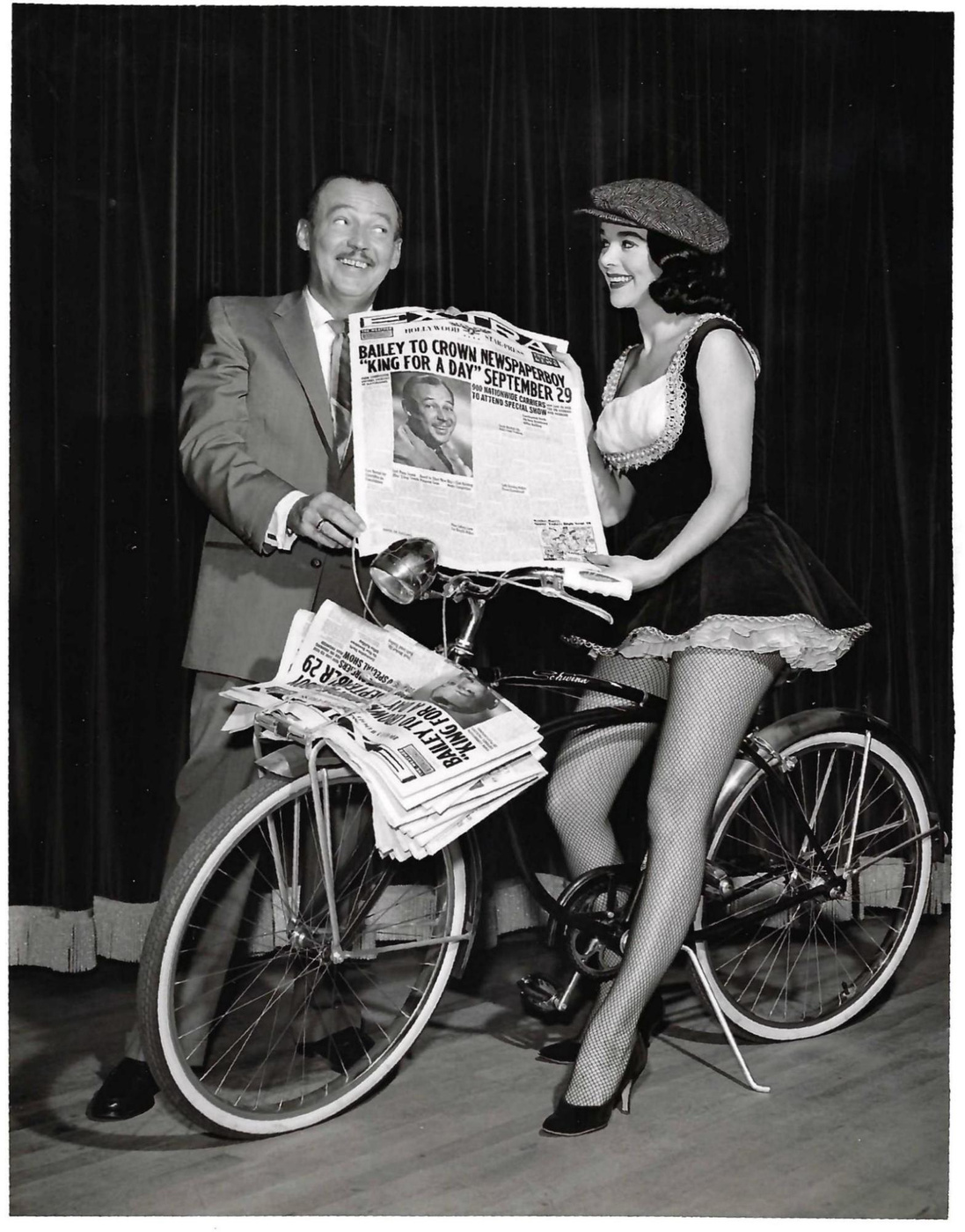
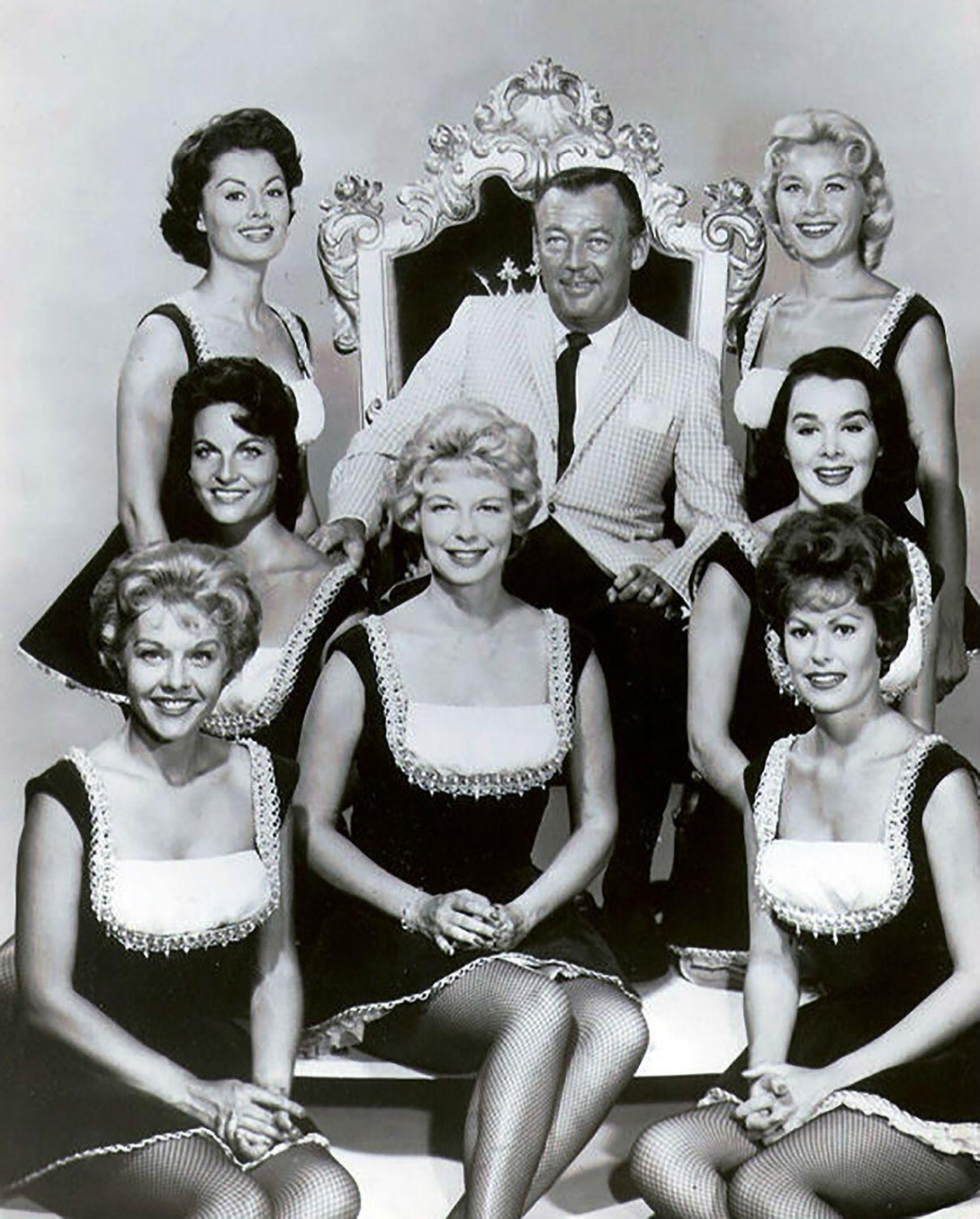
On April 9, 1955, columnist Gene Inge wrote an article on Suzanne titled “Beauty Queen Gets Change to Go Dramatic”
where he asked readers “She’s beautiful, but can she act?” It was the first nationally distributed profile on her, which she took advantage of by telling readers that she was serious about being a dramatic actress despite her modeling gigs.
Although Suzanne didn’t appear in Guys and Dolls (1955), she was chosen by Samuel Goldwyn to tour with the cast as one of the Goldwyn Girls after Pat Sheehan had left to star in Man with the Gun (1955). Suzanne traveled to countries like Australia, Brazil, Argentina, and Japan with stars Marlon Brando and Frank Sinatra. She was a guest of honor at parties, dances, and premiere, met with Presidents, and was showered with gifts. It was a year where she truly felt like a star. During the tour, she was interviewed by columnist Bob Krauss, who said that she had “the biggest, darkest, deepest, friendliest eyes you ever saw.” It was during the tour that she met actress Jann Darlyn, who would later model on Queen for a Day as well. Jann remembers Suzanne fondly, describing her as a “sweet, but shy girl.” The tour concluded and the models returned to Hollywood on June 24, 1956, having visited 15 countries, 55 cities, and three continents. Of the experience, Suzanne said “They [men] followed us wherever we went.”
Suzanne Alexander and Madelyn Darrow in Guys and Dolls (1955) ->
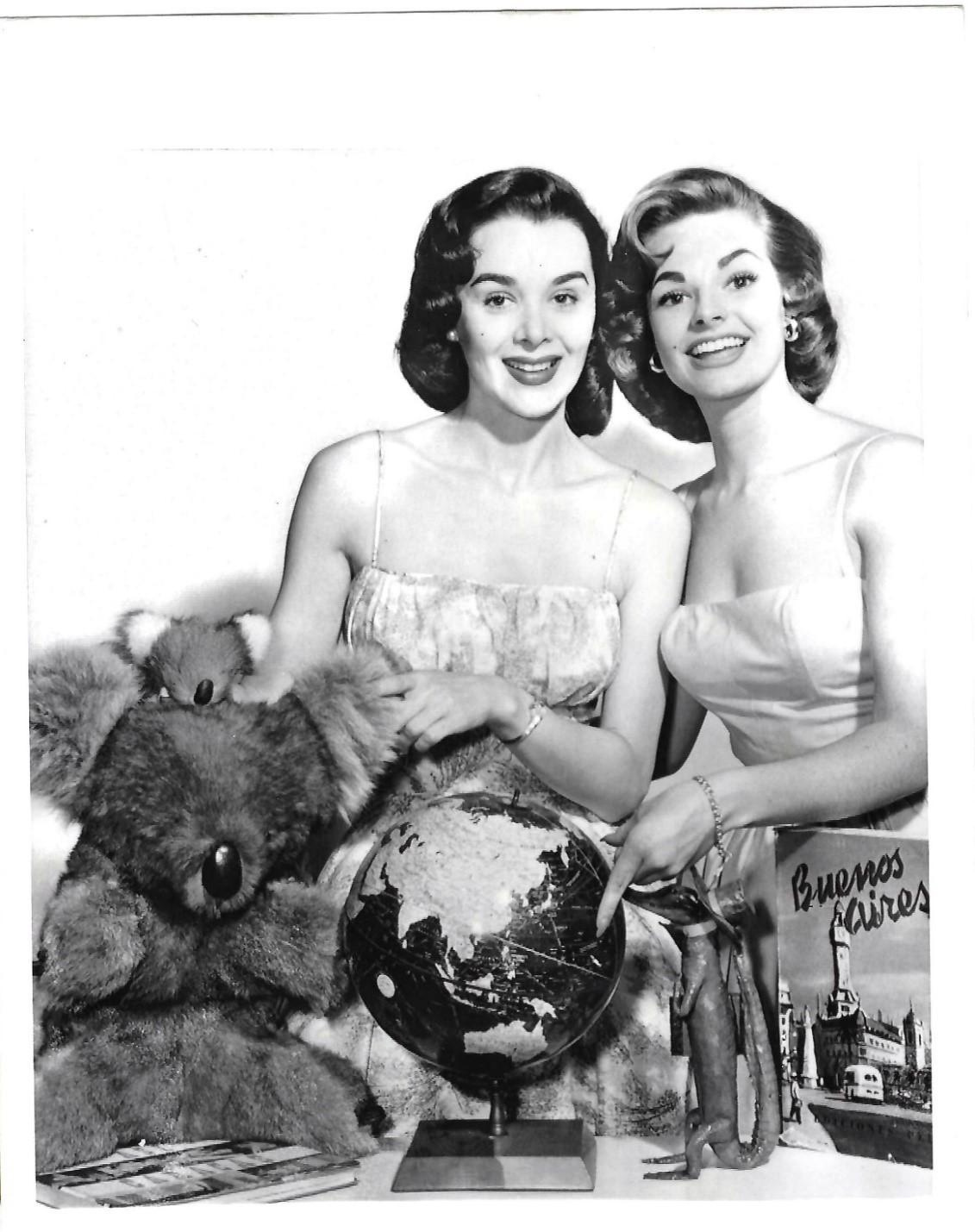
Suzanne Alexander Jann Darlyn, June Kirby, and Mr. and Mrs. Samuel Goldwyn - 1956 ->
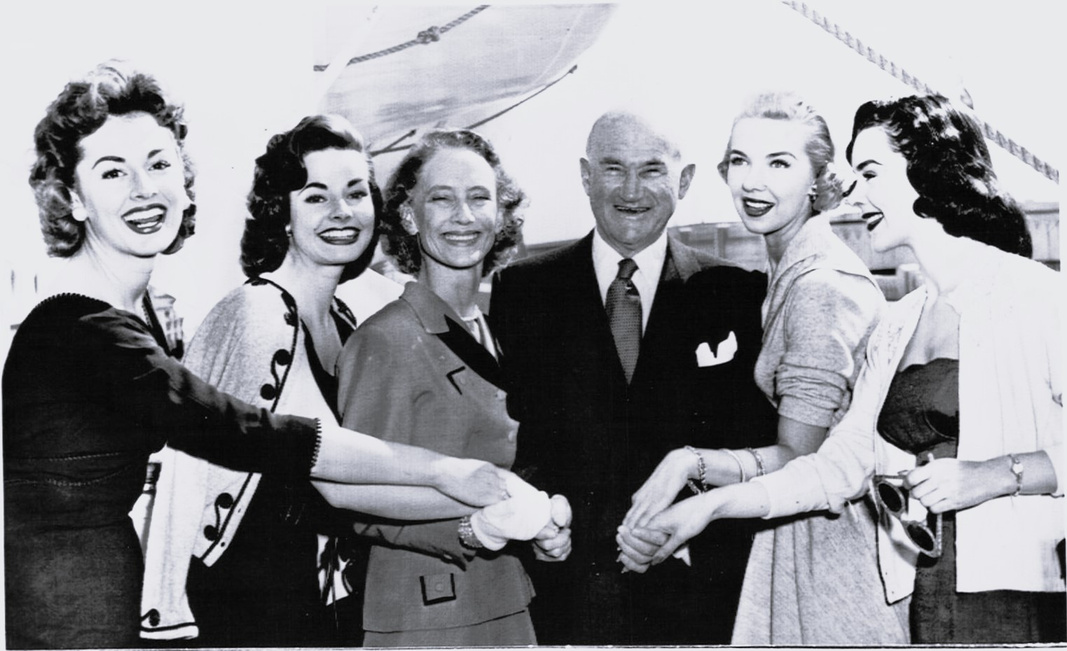
Decline
In what was perhaps Suzanne’s greatest opportunity -and disappointment- came when an agent saw her at a café with her mother and asked her if she would audition for Mike Todd’s Around the World in 80 Days (1956). Suzanne was one of the selected women who tested for the role -which is preserved at the Library of Congress- of Princess Aouda in 1955 after Donna Reed had rejected it, and she was the clear frontrunner. The other women who auditioned included Marla English, Jacqueline Park, Lisa Davis, Eleanor Tanen, Audrey Conti, Joan Elan, Sylvia Lewis, and Eugenia Paul. The role was then narrowed down to Suzanne and Marla, who did their final screen tests with actor David Niven on September 16, 1955.
Nobody –other than Suzanne’s mother- wanted Suzanne for the role more than the movie’s producer Mike Todd. Suzanne first met Mike in August 1953 after founding his post-production company Todd-AO. He had hired Suzanne that year to do screen tests for footage that he would use to present his recently developed widescreen technology to
studios. Although that hadn’t done much for Suzanne’s career, Mike hoped that Around the World in 80 Days (1956) would be a win-win for both parties.
Unfortunately, the producers chose Shirley MacLaine instead, who had rejected the offer twice before reconsidering. Had Shirley -whom would acknowledge years later that she was miscast- not changed her mind in accepting the role, Suzanne would’ve been cast as Princess Aouda. It was a major setback in Suzanne’s career, but she continued to have success on Queen for a Day -where she was earning $250 a week- and Juke Box Jury. The latter series -which she later shared hosting duties with Jean Moorhead- concluded shortly thereafter. The rights to the series are owned by Peter Potter’s former secretary, Ann Folsom.
Mike Todd had promised her that he’d find parts for her as he continued producing movies, but his eventual marriage to Elizabeth Taylor followed by his premature death on March 22, 1958 in an airplane accident ended the proposal. It was another stumble in Suzanne’s career, and it was then that she realized that success in Hollywood can change in an instant.
She regretted the direction that her career had taken, and she wished that she had continued the low-budget sci-fi genre where she had her greatest onscreen success.
Although disappointed, Suzanne didn’t let this ordeal keep her from what she enjoyed doing. She continued to pursue complex, in-depth roles on television. On May 3, 1956, she appeared in Four Star Playhouse -opposite Dick Powell- as Willie’s intoxicated date. That same year, she appeared on The Bob Cummings Show in what was a rare comedic role for her as a catty secretary named Louise.
In Crossroads a year later, she starred as Celeste in an episode titled “Anatole of the Bayous” set in New Orleans, Louisiana. She had an active role in this episode that included stopping a fight between and islander and a settler, alerting Anatole Martin -a minister- of a wicked deed that her love interest was planning to do, and helping bring peace between the islanders and the settlers. Her brother, Will, had become a recurring player in the series and had recommended his sister for a part. It was the only role Suzanne got with her brother’s help, as both siblings swore to carve their own paths in Hollywood.
Suzanne Alexander on Texaco Star
Theater - 1956 ->
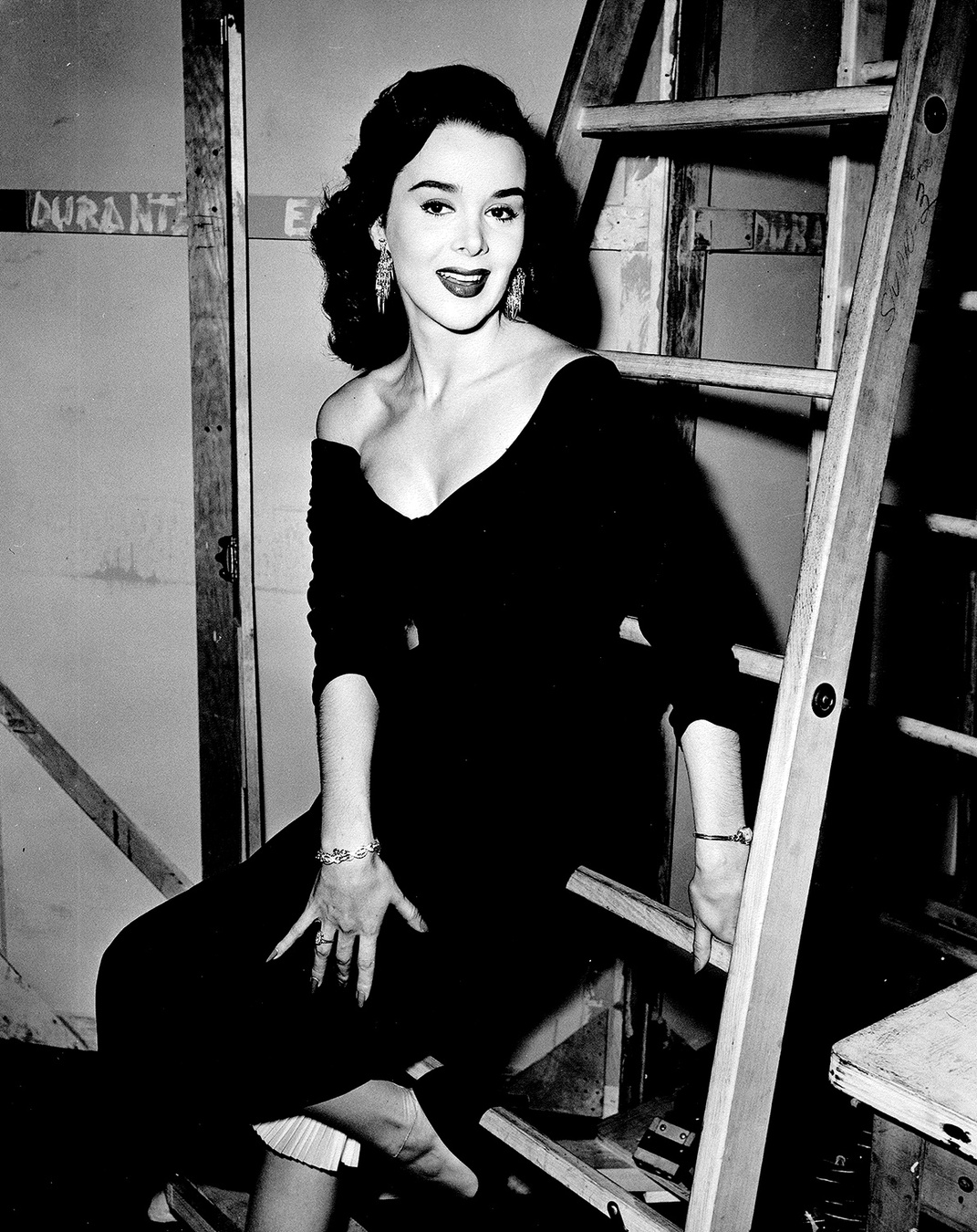
Suzanne didn’t have another substantial role in movies, instead being casted in walk-on roles in Solid Gold Cadillac (1956) and I Married a Woman (1958). The latter wasn’t a good experience, as Suzanne was given the news about her father’s death during rehearsals. Furthermore, it was her first onscreen role in years where she had no dialogue and a lot of her brief presence onscreen was behind a camera that her character was holding. It didn’t help that she -as well as the other gorgeous women in the cast- were upstaged by blonde bombshell Diana Dors.
She had a better experience in Solid Gold Cadillac, where the gowns she wore by Jean Louis earned the movie an Academy Award for Best Costume Design. Her role was as an unnamed model employed by the fictitious International Projects Corporation; dressed as an unconventional -and in her words, “a happy”- engineer, her character advertises the company’s diesel engine.
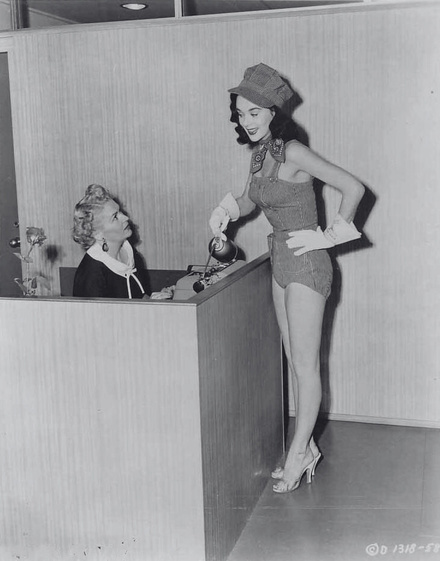
She played Joanne in The
Garment Jungle (1957), where
she was reunited with former
and current colleagues June
Kirby, Madelyn Darrow,
Millicent Deming, and Jann
Darlyn. The producer, Harry
Kleiner, said that he hired
Suzanne because she was
“slender, but not too slender.”
Although she only had one
line, she did partake in a lot
of publicity for the movie’s
release which included
newspaper and magazine
pictorials. Sadly, her one line
“That must be the boss’ son”
was so insignificant and
unimportant that even her
co-stars Kathy Marlowe and
Marilyn Hanold have no
recollection of her being in
the film.
Suzanne Alexander in Solid Gold
Cadillac (1956) ->
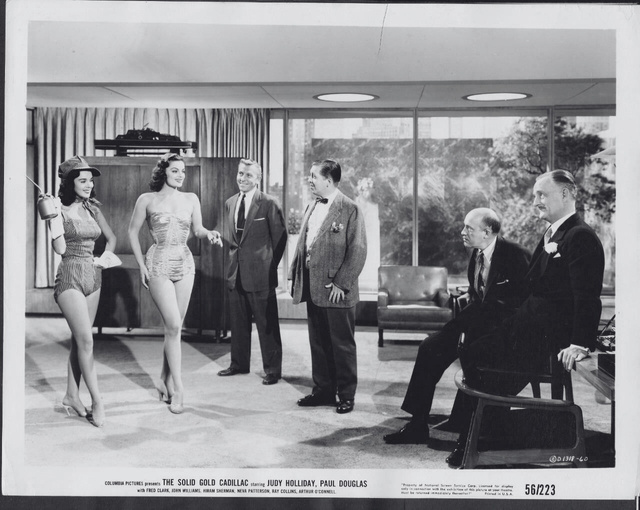
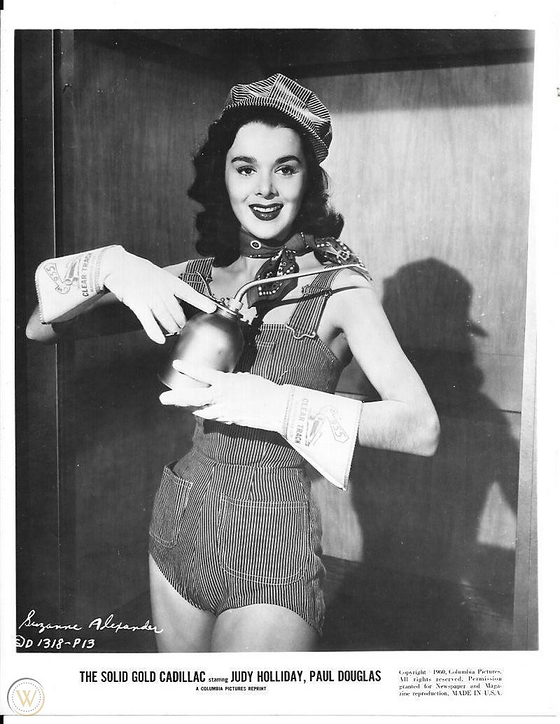
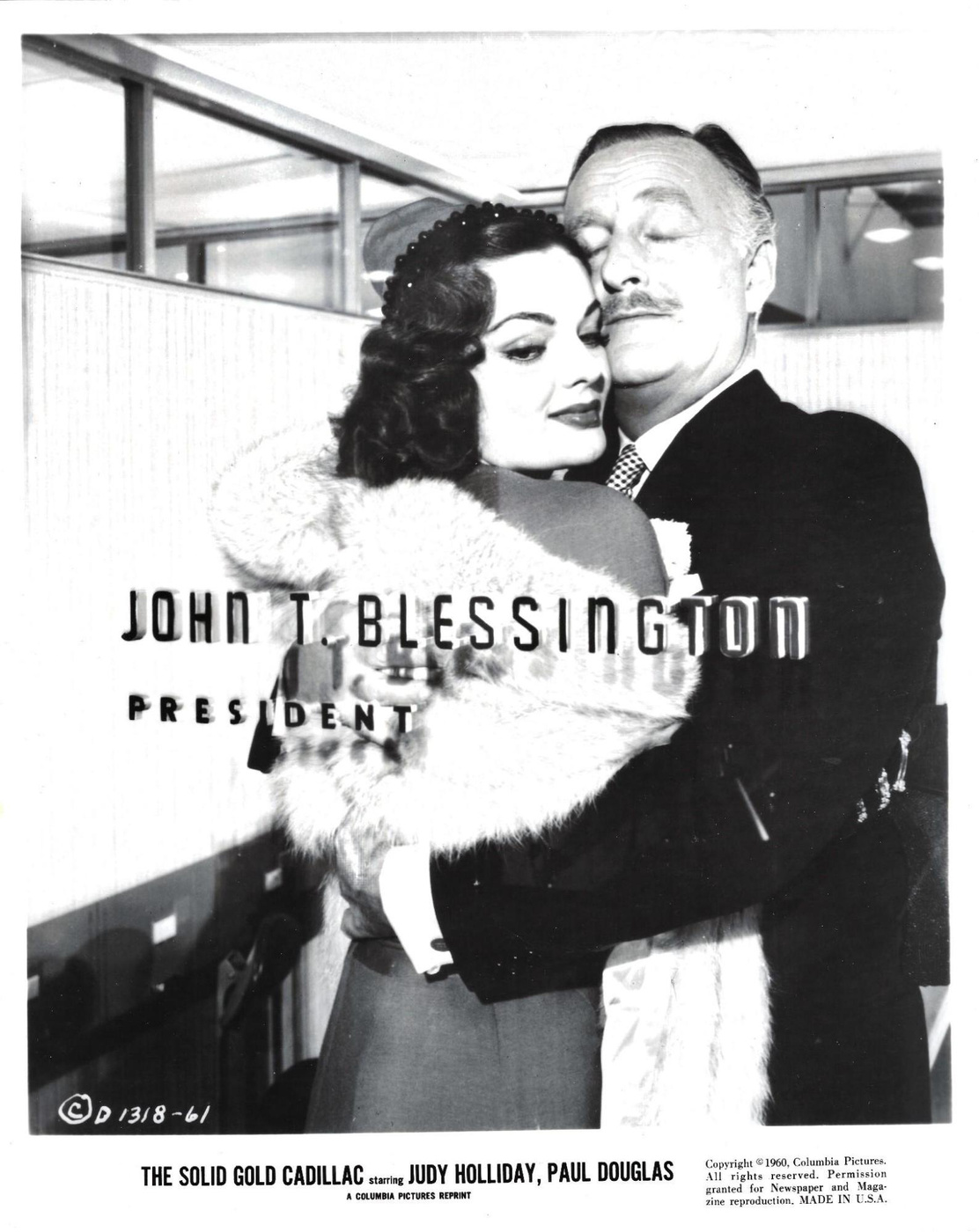
It was mid-1958 when Suzanne was offered to take part in a pilot of Steve Canyon, based on the successful comic strip by Milton Caniff. She would portray Nurse Jeets, a no-nonsense nurse who cares for wounded soldiers. Although she was meant to be a recurring character, her role was written out of the series because producers wanted scripts that focused on the characters in the original comic strips. It wouldn’t have done much for her career anyways, as the series was cancelled after two seasons.
Although disappointed, she had a lot of additional television work that year that kept her busy. She had a role on an episode of The Loretta Young Show titled Air Stewardess where she -as Andrea Dodd- portrays the lazy, complaining, and unsympathetic roommate of an airlines stewardess. After hearing echoes of the airplanes from the nearby airport, she says “we really outta move.” This and other television appearances of Suzanne’s are preserved at the UCLA Film & Television Archive.
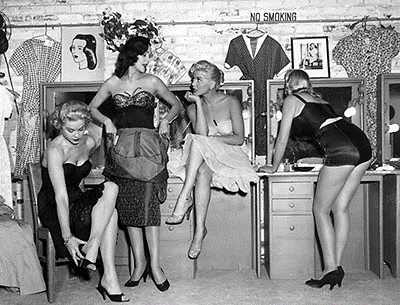
Suzanne Alexander and Ellie Kent in The Garment Jungle (1957) James Bacon did a story on her titled “TV Gal Seen, Not Heard” in 1959, which documented her career on Queen for a Day. It was a last-ditch effort -during an uneventful week in news- to revive her waning career, with her saying “I’ve wanted to be an actress and model ever since I can remember” while giving intimate details about her life that included her habit of talking to herself before rehearsals and using a secret “modeling formula” to mentor models.
Arguably her greatest advice to actresses in this interview was
“In acting, you always have to remember that the audience has never heard the line before, and you have to deliver it so they understand it.”
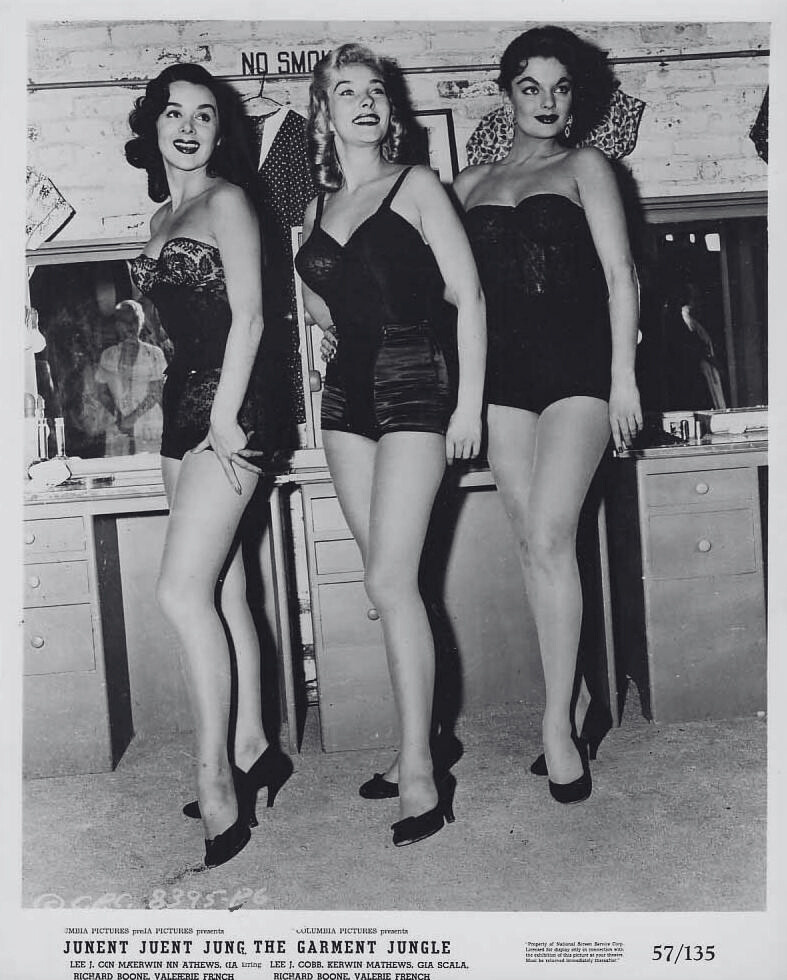
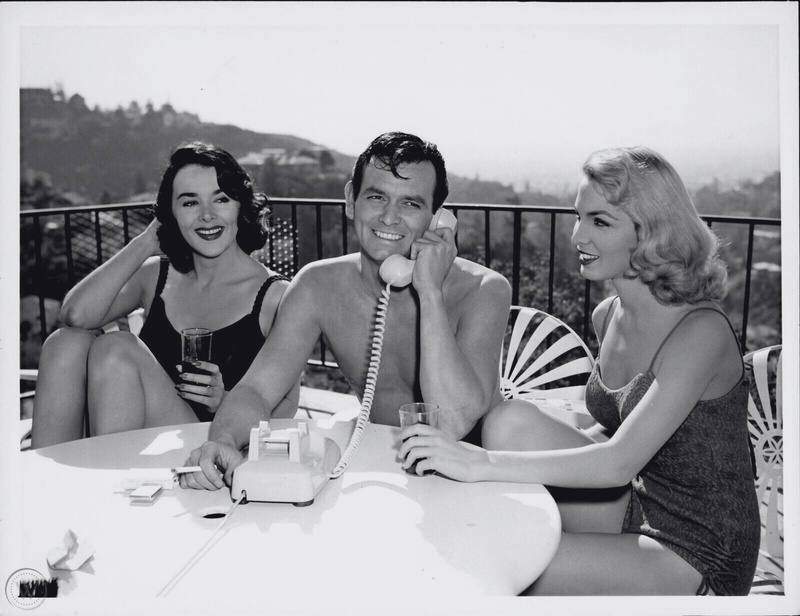
Suzanne Alexander with David Janssen and Gloria Tennes on Richard Diamond, Private Detective - February 15, 1959
She did some modeling for a cosmetics company called Rogue and did -in what would be her last acting role onscreen for thirteen years- a guest role on Richard Diamond, Private Detective as an unnamed brunette who -
along with a blonde played by Gloria Tennes- refuses to use the pool with Richard because “girls from California don’t swim.”
Unfortunately, her career began to fade as the decade ended; with fewer acting roles being offered to her, she took modeling gigs which included an international tour for the Rose Marie Reid Swimming Suit Company called
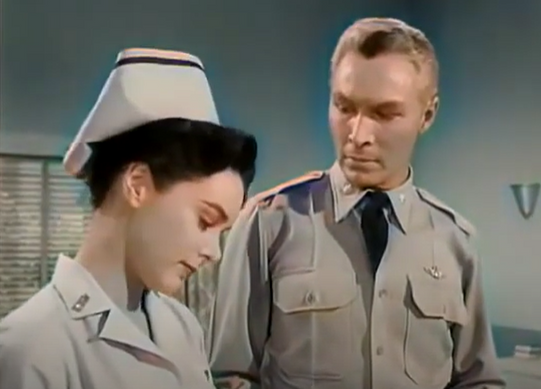
“Swimshapes by the Ounce” with co-star and friend Carol Silversparre. They traveled to Australia to promote the swimwear at the Reef Hotel on March 14, 1959.Marianne and Charlotte Guice were models -and twins- who participated in the three-week tour. They remembered Suzanne as being modest and unassuming. Marianne spoke about how Suzanne would do anything asked by the modeling agency, while Charlotte recalled a more troubling incident where a stewardess accidently spilled coffee on Suzanne’s back as there was turbulence. Suzanne did another tour with the company a year later, only it was throughout Europe. Mona Nardone, another model on this tour, remembered the models buying Rolex watches for their spouses and boyfriends while Suzanne -who was single- bought one for her brother.
Suzanne Alexander on Steve Canyon - September 13, 1958
Later Years
As the 1960’s approached, Suzanne changed her appearance to reflect the changes of the decade. She trimmed her hair in favor of a “bob cut” that had been made famous by Vidal Sassoon while changing her red lipstick to a shade of pink.
She premiered this look in TV Guide on August 13, 1960 in the hopes that she wouldn't be left behind in the prior decade like a lot of her contemporaries were.
“The hardest thing about our job [on Queen for a Day] is the wardrobe change. Sometimes I have three minutes to get from my page outfit into my dress. That feels like an eternity. Sometimes, we only have seconds to do so.” – Suzanne Alexander in The Tampa Tribune on June 28, 1959
Additional models were hired on Queen for a Day, including Lois Schaumberg, Doris Gildart, and Dorene Georgeson.
None of them were as popular with audiences as Suzanne was. She had a likeable persona that people loved. She was a headliner on Queen for a Day’s 18th anniversary on April 27, 1962 and continued to star on the series until its conclusion on October 2, 1964. The models remained close though, with Suzanne being a bridesmaid at their weddings.

on October 2, 1964. The models remained close though, with Suzanne being a bridesmaid at their weddings.
Suzanne married Rexford “Rex” Colbert -known as one of Hollywood’s eligible bachelors- on September 28, 1963 at the All Saints Episcopal Church in Beverly Hills, California, after being pressured by her mother to do so in the hopes that he -
who was employed with Metro-Goldwyn-Mayer as an executive- could boost Suzanne’s career. He was 17 years older than her though, and they barely knew each other.
Suzanne approached her mother on the day of her wedding, saying “I don’t wanna do this.” Her mother replied, “We’ve already paid for it. You’re wearing the dress. It’s going to happen.” She was giving Suzanne her freedom, but in
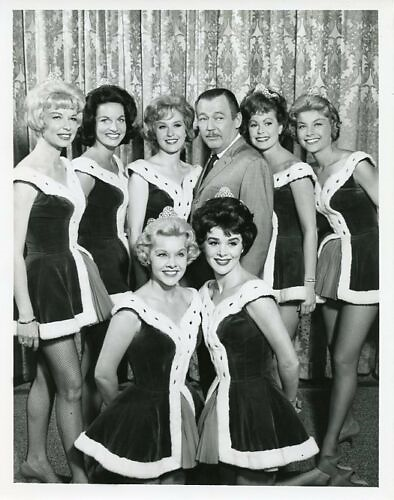
Suzanne’s eyes, her mother was abandoning her.
"I’m surprised that her mother [Gwendolyn] would let her marry Rex. She was so controlling of Suzanne. She must’ve had a lot of faith that he could boost Suzanne’s career.” – Jolene Brand in 2021
Their marriage was short-lived, and they divorced in May 1966. It certainly didn’t boost Suzanne’s career either, as her husband wanted her to abandon her career in lieu of a traditional life as a wife and mother. Suzanne -and her
mother of course- resented the idea, which contributed to their eventual divorce. Rex never remarried, and became a hotelier and restaurateur in Southern California. He died on April 2, 2002 in Los Angeles, California.
She decided to reevaluate her career as an actress, and took courses in design. She secured employment with an apparel company where she designed outerwear. She continued to do modeling though, and made her last appearance onscreen on an episode of Mod Squad titled “The Wild Weekend” as a saleslady in a flashback that Pete and Sally were having.
Although she had a mere four lines, she looked fantastic; with her “Manhattan Rose” lipstick, only Suzanne could make a cameo look glamourous. In a decade where a lot of her colleagues “aged out” of the industry, Suzanne had continued to pursue her dream.
While Suzanne was chasing the fading dream, her brother Will had become a successful character actor. He appeared on The Good Life, Ironside, Bonanza, and Perry Mason. He usually portrayed guards, officers, detectives, reporters, and sailors. Although he had offered to help Suzanne, she always refused as she was determined to maintain her independence.
Will married Elaine Devry, an actress and Mickey Rooney’s ex-wife who had respectable roles in The Atomic Kid (1954) and China Doll (1958) before establishing herself as a character actress. They eventually retired from the industry
and lived in Grants Pass, Oregon far from Hollywood. Will died on April 23, 1992 in Grants Pass, Oregon.
“She was a sweet girl who had a very tragic ending.” – Elaine Devry in 2021
Suzanne always wanted a sister, which is what she found in Elaine Devry. They had a lot in common; they were gorgeous actresses, both were born in the 1930’s, and they were against using nepotism, seminude modeling, and dating to further their careers. They were very close, and it was good for Suzanne to have another role-model besides her mother. In addition, Suzanne was impressed that Elaine was willing to forfeit her alimony with Mickey Rooney in order to marry Will. It showed dedication and love, and Suzanne was glad that her brother whom she was close with had somebody like that in his life.
As the 1970’s progressed, so did Suzanne’s troubles. In an era where most models were forcibly retired after reaching their 30’s, Suzanne struggled trying to act and model in her 40’s, facing mounting financial woes and the sorrow of being phased out of an industry that she had known for decades.
She fell into a depression, unwilling to seek treatment for fear of the stigma that she felt she would endure. She spent her days in a modest apartment in Los Angeles, California waiting
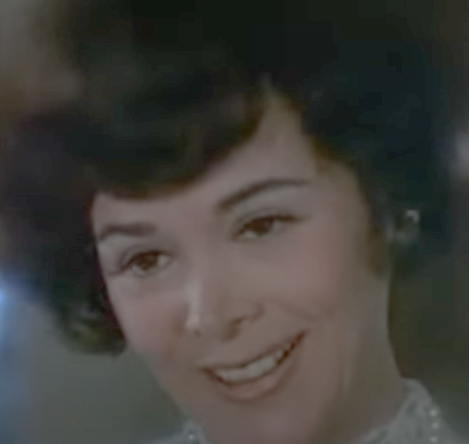
by the telephone for anything offered to her.
“She was more than a co-worker though. She was a friend. She was the bridesmaid at my wedding. I even named my daughter after her… I think that the reason her acting career didn’t launch was because she didn’t like it enough. She always said that she loved acting, but that was just her trying to please her mother.” – Carol Silversparre in 2021
Suzanne Alexander on Mod Squad - February 15, 1972
On September 21, 1975, Suzanne arrived at the Sheraton-Palace Hotel in San Francisco, California for a convention.
She was there to model coats that she designed for an apparel company who was showcasing at the San Francisco International Antique Show. In a frantic state, she locked herself in her third-floor room and leaped to her death. There was no note left, and people were in disbelief. Her mother collapsed after hearing the news, and her co-workers didn’t
notice any signs of distress beforehand. Some of her friends believed that her suicide was cocaine-induced while others suspected that she was murdered.
Suzanne was interred at Forest Lawn Memorial Park
“Hollywood Hills” in Los Angeles, California. Her mother -
who blamed herself for her daughter’s death- would be buried next to her two years later. Suzanne’s funeral was attended by her family, friends, and co-stars. The San Francisco Examiner and the San Francisco Chronicle published obituaries for her, but they didn’t do her justice.
Although there was confusion and disputes about her reasons for having committed suicide, people who knew her agreed that earth lost an incredible star that day and an even better person. She was a kind, sincere, and humble woman who was more talented than anyone would ever know.
Suzanne Alexander on Crossroads -
April 20, 1956 ->
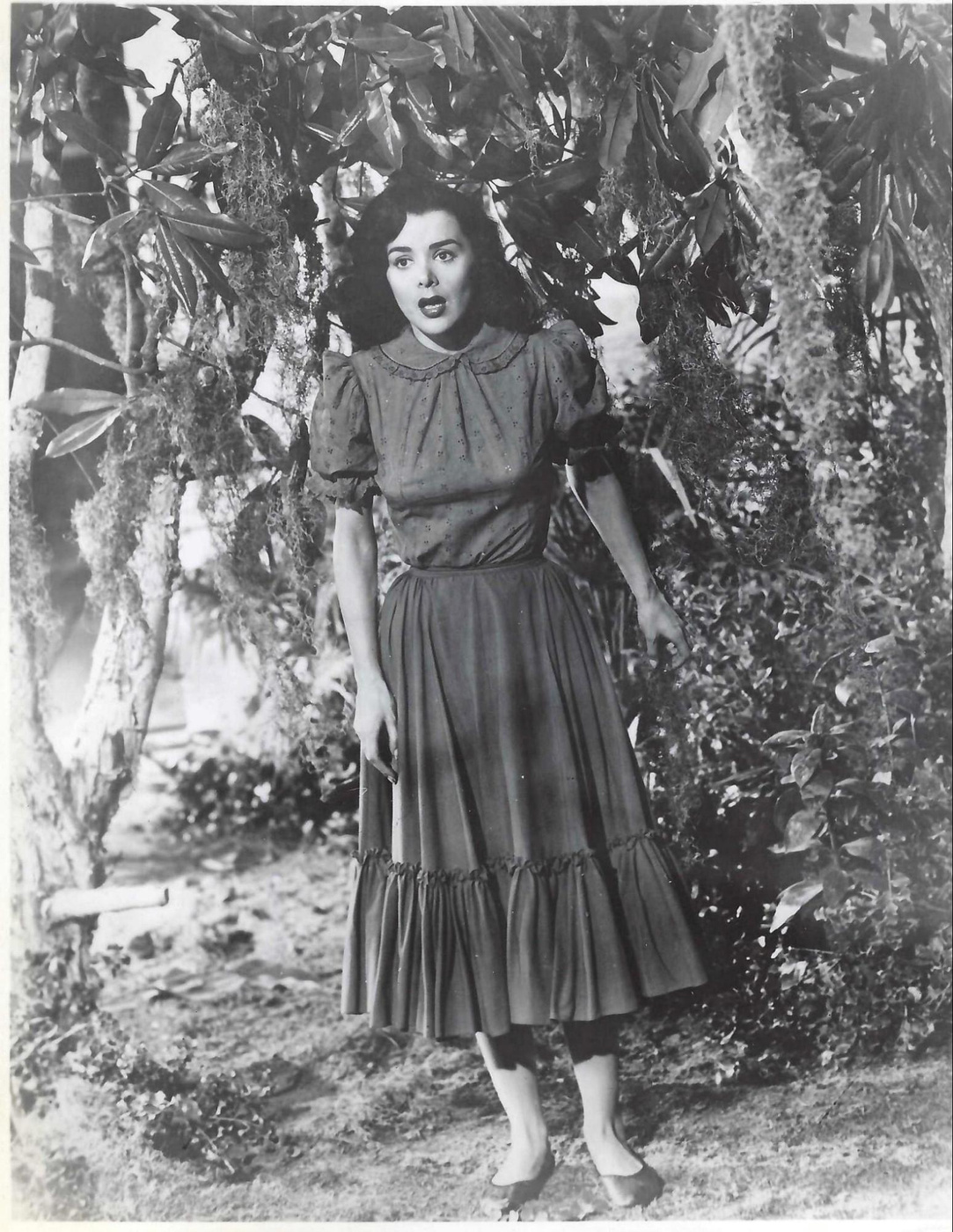
Afterword
I was honored to have told Suzanne Alexander’s story. After completing it, I decided to do two things while waiting for my editor to review it. I visited Suzanne’s grave at Forest Lawn Memorial Park outside of Burbank. She was buried in the park’s Hollywood Hills cemetery where stars like Bette Davis, Lucille Ball, and Gene Autry were laid to rest. I walked to the cemetery’s “Murmuring Trees” section and found her modest grave beside her mother, much to my disliking.
I was saddened when I saw that there was no mention of her being an actress on her tombstone, nor was there any mention of her as a person. The tombstone read “THE LORD
IS MY SHEPHERD” which perhaps implied that she was a religious person. I polished it a bit as it was unkempt, and I placed a dozen roses beside it.
Months later, I went to the Library of Congress in Washington D.C to see her test footage from Around the World in 80 Days (1956). It was filmed in September 1955 after months of producers vetting various actresses. The footage, which had
been donated by Elizabeth Taylor along with hundreds of other reels from the production, had been untouched for decades. In what was labeled as the AFI/Elizabeth Taylor Collection, the librarian found two boxes of material in its original format that would have to be digitized for viewing and listening.
The first box contained the sound to accompany the footage, which was labeled “Optical Test Track (35mm, Sound only)”
had two discs labeled FPE 8414 and 8415 with Suzanne -
written as Susan- Alexander, Marla English, and David Niven on accompanying documentation. The other box consisted of two video reels labeled “Positive (35mm, color, Silent) in makeup and costume for role of Princess Aouda” with a note that read “Last-2-Girls: Marla English, Susan Alexander.”
Her screen test for Around the World in 80 Days (1956) was one of the rare opportunities where she got to do legitimate and substantial acting. The footage is now digitized and available for anyone to view. I liked her performance as Princess Aouda. She did fantastically well in her portrayal of the role, and she had features similar to that of the Indian princess. It was an opportunity missed for audiences of the Oscar-winning movie. The first test had her walk and turn for the director. She introduced herself by saying the following:
" My name is Susan Alexander, and I am from Toronto, Canada. I've done
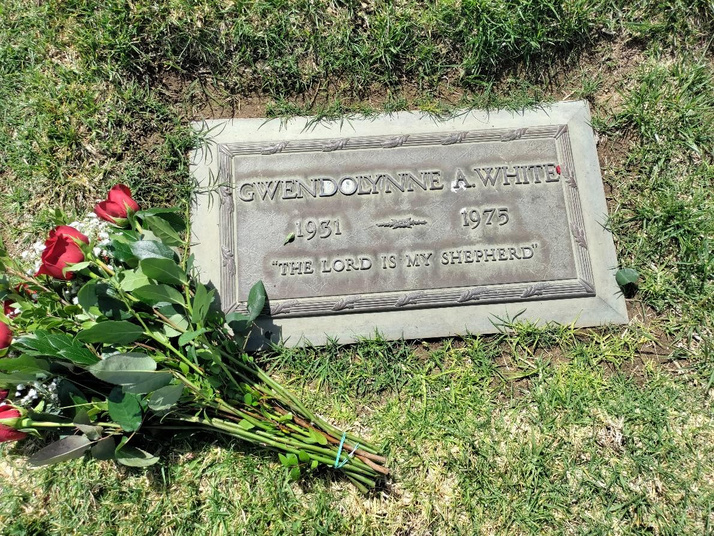
a lot of television, but motion pictures not so much. My biggest one to date was Down Three Dark Streets. .
The following test -which only she and Marla English did-had her reenact a scene from the script. I could be bias, but I felt that she outperformed Marla English by lightyears. She had the experience, talent, and beauty that no other actress could provide for that role. I strongly recommend that anyone who's in Washington D.C see the footage, as you won't be disapppointed.
Suzanne Alexander modeling for Trans
American Airlines – March 24, 1965 ->
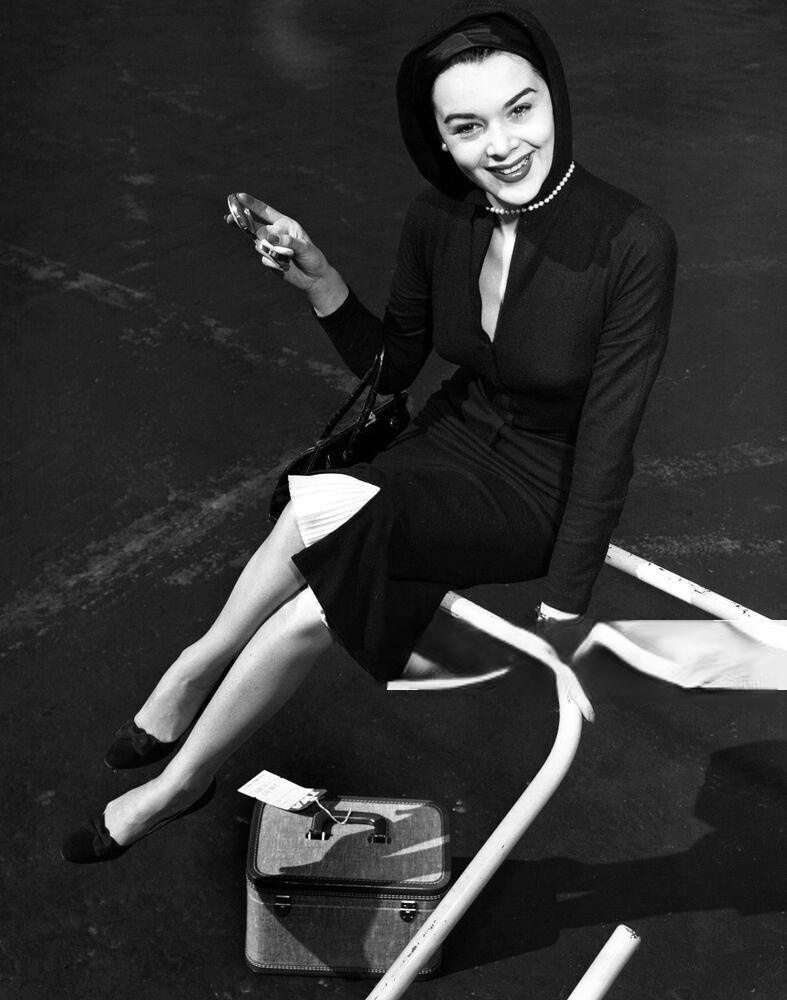
Filmography
Raiders of the Seven Seas (1953) - Handmaiden Latin Lovers (1953) - Brazilian
The Affairs of Dobie Gillis (1953) - Co-Ed Cat-Women of the Moon (1953) - Beta
Flight Nurse (1953) - Madonna
The French Line (1954) - Model
Princess of the Nile (1954) - Handmaiden Down Three Dark Streets (1954) – Brenda Ralles Daddy Long Legs (1955) - Admirer
Son of Sinbad (1955) - Harem Girl
The Girl in the Red-Velvet Swing (1955) - Floradora Girl The Solid Gold Cadillac (1956) - Model Garment Jungle (1957) - Joanne
I Married a Woman (1958) - Camera Girl
Television
Hollywood Opportunity
Self - May 6, 1949
The Meakins
Self - May 10, 1949
KPIX San Francisco
Miss California | Self - June 2, 1949
Ladies Matinee
Unknown Episodes | Model - 1952
Schlitz Playhouse
The Last Kiss - January 16, 1953
Parents' Week-End - March 20, 1953
Photography is Fun
How to Pose Nude | Ballerina - April 27, 1953
Racket Squad
The Case of No Questions Asked | Lillian Lester - February 21, 1952
Fraudulent Nursery School | Lillian Lester - August 3, 1953
China Smith
Straight Settlement | Maria Torres – August 28, 1953
The Pacific Panorama Show
Miss Rheingold| Self – August 23, 1954
The Larry Berrill Show
Miss Rheingold| Self – August 29, 1954
Public Defender
The Sapphire Mink | Diane Collins - April 7, 1955
It’s a Great Life
The Inheritance | Virginia - May 17, 1955
The Bob Cummings Show
Air Corps vs. Marriage - April 17, 1955
Bob's Birthday | Model - June 12, 1955
Snowbound | Louise - February 16, 1956
The Alcoa Hour
Unknown Episodes | Model – 1955-1957
Texaco Star Theater
Ernest Borgnine | Model - April 7, 1956
George Jessel | Model - April 21, 1956
Crossroads
Anatole of the Bayous | Celeste Martin - April 20, 1956
Four Star Playhouse
A Long Way from Texas | Willie’s Date - May 3, 1956
Wire Service
Hideout | Val - October 18, 1956
The Adventures of McGraw
The Torn Map | Nancy - July 30, 1957
The Loretta Young Show
Air Stewardess | Andrea Dodd - Mar 30, 1958
Steve Canyon
Operation Towline | Nurse Jeets - September 13, 1958
Richard Diamond, Private Detective
The Sport | Brunette - February 15, 1959
Juke Box Jury
Various Episodes | Self – 1953-1959
Queen for a Day
Various Episodes | Model – 1954-1965
Mod Squad
The Wild Weekend | Saleslady - February 15, 1972
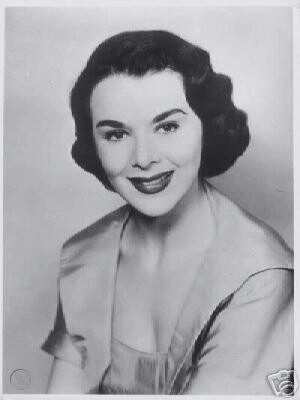
Pageants
Miss Studio City of 1949 – Winner
Miss San Fernando Valley of 1949 – Winner Queen of the Fiesta of 1949 – Winner
Miss California of 1949 – 4th Place
Queen of the Home Show of 1952 – Finalist Miss Vegetable Plate of 1953 – Winner
Miss Rheingold of 1954 – Finalist
Peter Potter’s Girl Friday of 1954 – Winner
